Western Ireland
Sunday 22 – Friday 27 May 2022
Three participants on the trip to Ireland contributed their individual reports, photos and descriptive notes. The attraction of the Burren for MPG members was the exceptional combination of Mediterranean, Alpine and Arctic flora in the karst scenery of the north of County Clare. The timing of the tour was perfect for catching wild plants in flower and there was the bonus of visits to gorgeous gardens on the last two days. The group of 20 members stayed in the Shannon Springs Hotel, close to Shannon airport. Twenty members arrived on Sunday evening, most in time for dinner together before the expeditions began first thing next day.
Monday morning 23 May (Bridget)
We arrived in glorious sunshine at Caher Bridge Garden nestled next to the river Caher inland from Fanore.
Greeted by Carl Wright at the entrance, we heard the history of the cottage and the challenge of starting a garden on an exposed area of the Burren with virtually no topsoil and a crumbling cottage. Set in an acre of craggy limestone pasture and woodland, Carl set about creating beds and borders using local stone and shipping in hundreds of tons of soil which was meticulously sieved to eradicate pernicious weeds. Carl emphasised how the house and garden should blend and complement each other as well as the surrounding landscape.
As expected, the sunshine was swiftly followed by torrential showers and an onslaught of midges, which on some days prevent Carl venturing into the garden at all. With an average of 250 days of rain per year and low light levels, shady, wet-loving plants were the obvious choice when Carl set about creating the garden. We started in the water garden which is a series of beds and channels seamlessly merging with the flowing river. The vulnerability of this area was highlighted by Carl when recalling the flooding of the garden in 2014 when the Caher broke its banks. Not one to shy away from hard work, Carl took on the challenge to rebuild the water garden to tremendous effect. Beds filled with Libertia chilensis ‘Formosa Group’ mingled amongst abundant scatterings of Primula Candelabra hybrids in oranges, pinks and yellows creating shelter and a natural feel, with 23 species of Crataegus, the largest collection in Ireland. Deciding to keep native hazel existing on the property and seen throughout the Burren at the beginning of Alnus x bachii and difficult to find Salix magnifica, Carl is keen to mimic the endemic species found in the area. Geranium x magnificum softens the stonework borders.
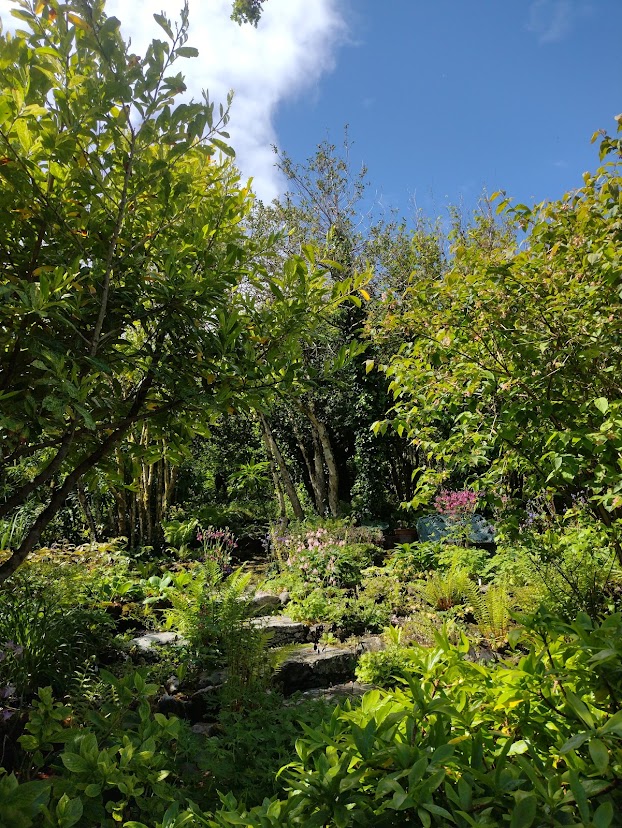
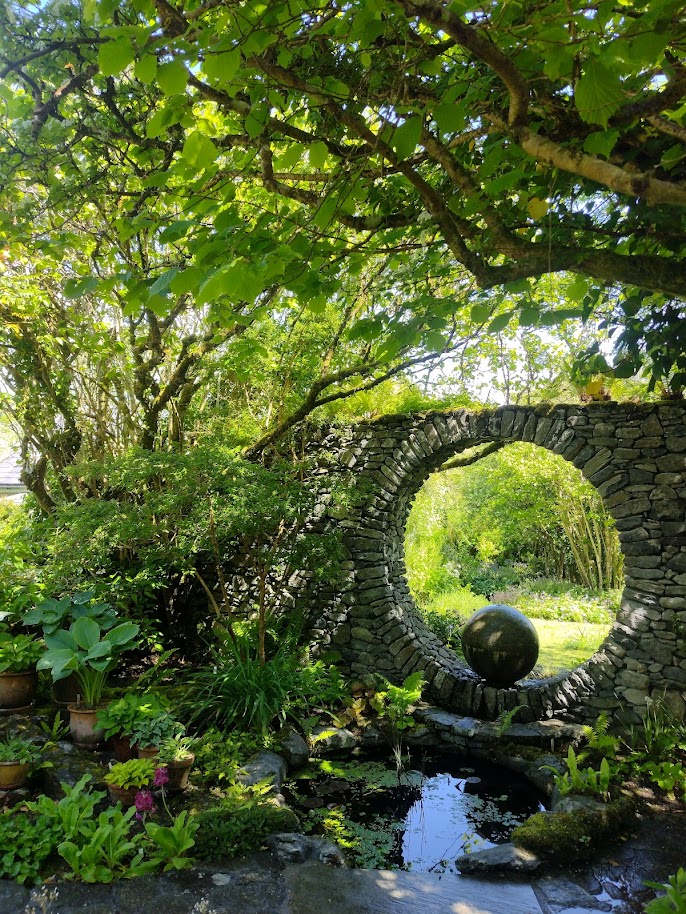
Caher Bridge Garden
Carl’s enthusiasm and love for the wild Burren landscape is infectious, possibly one of the driving factors in his tireless efforts to ensure the garden sits sympathetically within this setting, designed to be a hotspot for biodiversity, insects and wildlife with chuffs, buzzards, ravens, grasshopper warblers, swallows and dippers often spotted. Bergenia ‘Schneekoenigin’ an interesting German hybrid with the palest shell-pink, almost white, clusters of flowers elegantly held high above the foliage on red stems, providing reliable cover sitting happily in the moist, partially shaded beds. Myosotis arvensis, Eupatorium and countless other naturalised wildflowers mingle amongst a mix of Camassia quamash, Fritillaria and countless spring bulbs enhancing the naturalistic planting.
The rhythm and theme of spherical shapes continued with the iconic moon gate built by Carl which not only creates a sense of mysticism but also serves a practical purpose in dividing the garden and allowing some privacy. As we entered the more private cottage garden behind the house my eye was drawn to a semi-circular stone altar displaying succulents and a clump of striking Sarracenias which were in flower. Sempervivum tectorum spilled out of the moon gate window.
We entered the cottage garden enveloping one side of the house with a more open feel from the shady riverside with its flowering aquilegias, clearly a favourite of Carl’s and useful for filling in the May gap. Carl described how he allows them to run amok and seed wherever they feel inclined to settle each year bringing an array of new colours, shapes and forms.
Then we once again found ourselves under a shaded canopy ascending a slope amongst hellebores, and delicate Gymnocarpium dryopteris. Saxifraga stoloifera punctuated the green hues of the ferns as the reality of carving this garden out of the wilderness was highlighted the further we ventured up towards a shaded area with a series of terraces painstakingly built from stone. Pots of hostas nestling in the stonework of beds were a playful way of presenting them and creating an ever-changing display.

View to the surrounding landscape
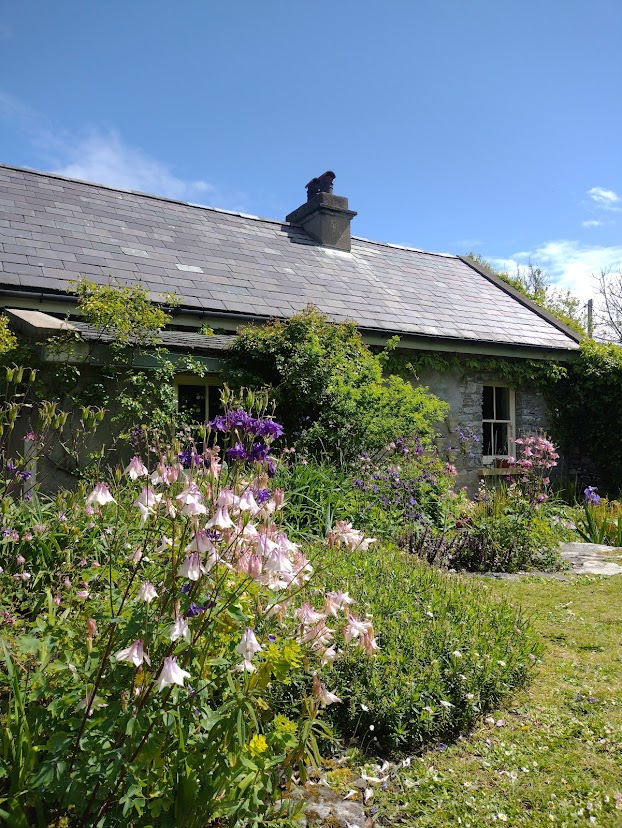
Caher Bridge cottage
The impressive stonework, constant throughout the garden, mimicked the unique rockscapes found in the wider landscape. Upon reaching the top of the garden an opening appeared and we were presented with breath-taking views of surrounding limestone pavements. The meadow is home to 16 varieties of Irish-bred daffodil cultivars with mown paths inviting you to reach the highest point of the garden and another of Carl’s impressive stone structures, a tower with an incredible circular void on one side. The apple orchard, home to native Irish varieties including two specimens with possible undiscovered varieties have been found and are currently being DNA tested. The disappearing native hazel once synonymous with the Burren encircled the perimeter of the meadow blending the garden into the wider landscape. Limestone slabs made ideal spots to sit and take in the rugged vistas.
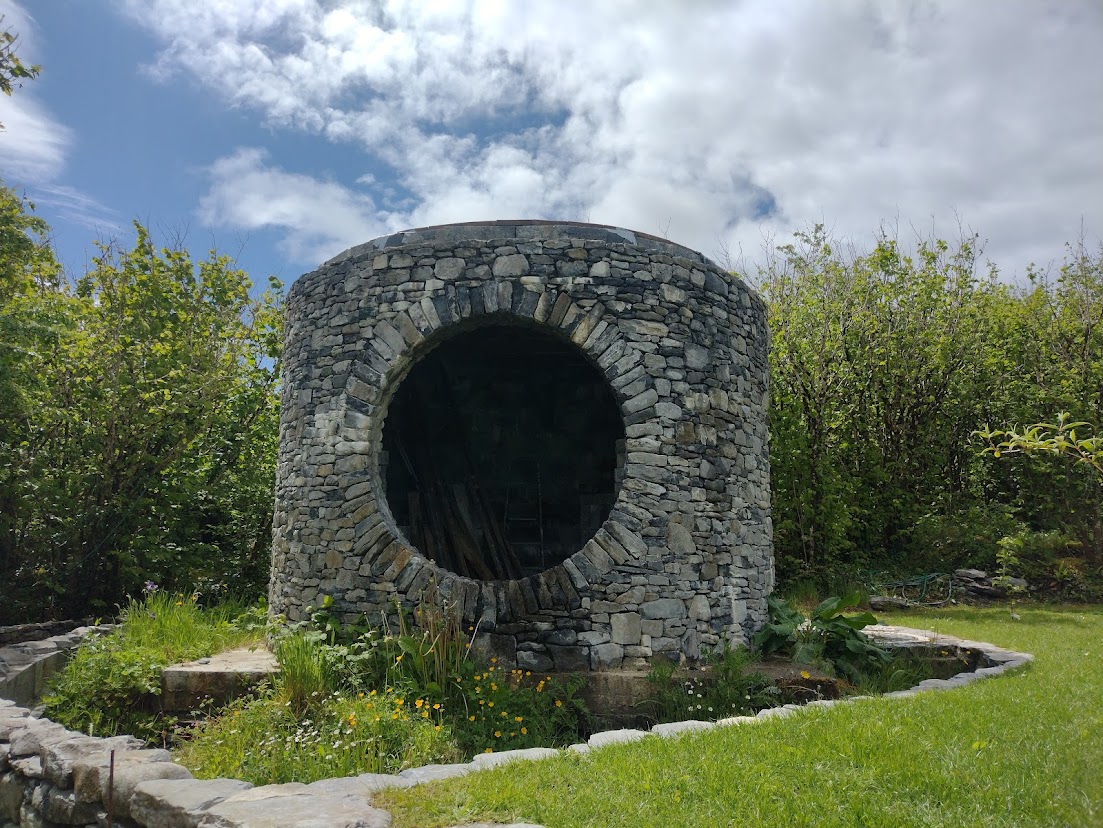
We left Caher Bridge Garden inspired by what Carl, with the help of his father, has created. Onwards to Ballyvaughan where we stopped for a delicious lunch of soup, sandwiches and hefty wedges of cake at the opposite the harbour, at the Tea and Garden Rooms, a picturesque setting approached through its pretty front garden and overlooking Galway Bay.
Monday afternoon 23 May (Vida)
After lunch, Carl took us to a wildflower walk where we first passed through what can only be described as an orchid meadow. Thousands of early-purple orchids (Orchis mascula) ranging from a nearly white, pale pink to the darkest purple carpeted the ground. They were not the only orchid to be found here – common twayblade (Neottia ovata) was also quite common, but the green flowers are much more difficult to spot.
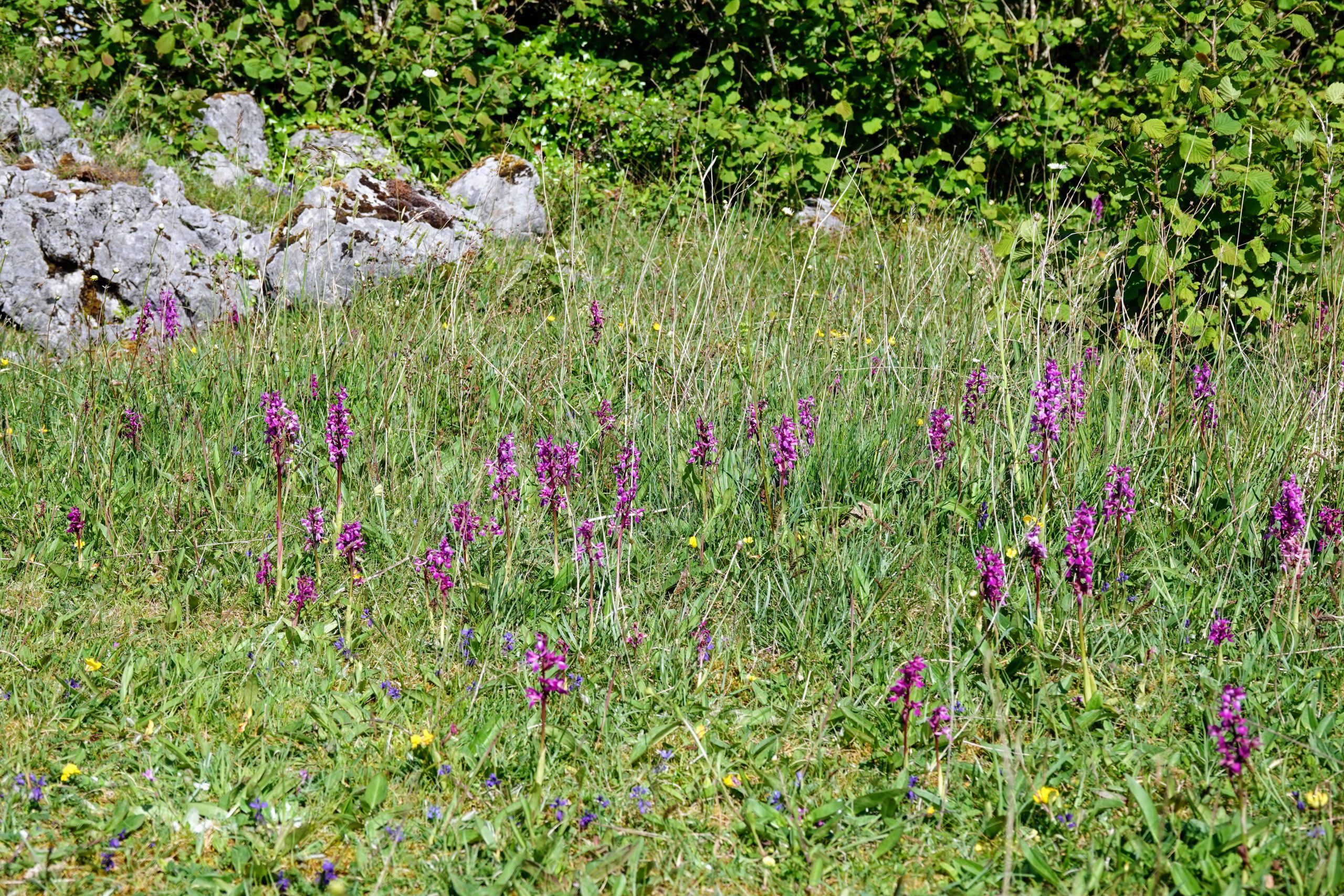
Orchis mascula in orchid-rich meadow
The orchid we were all searching for was, however, the fly orchid (Ophrys insectifera). After a few minutes of careful searching, we managed to find a few which had just started to open their lower flowers. The dark, slender flowers might resemble flies but they are actually highly effective mimics of female digger wasps, both visually and through the release of pheromones.
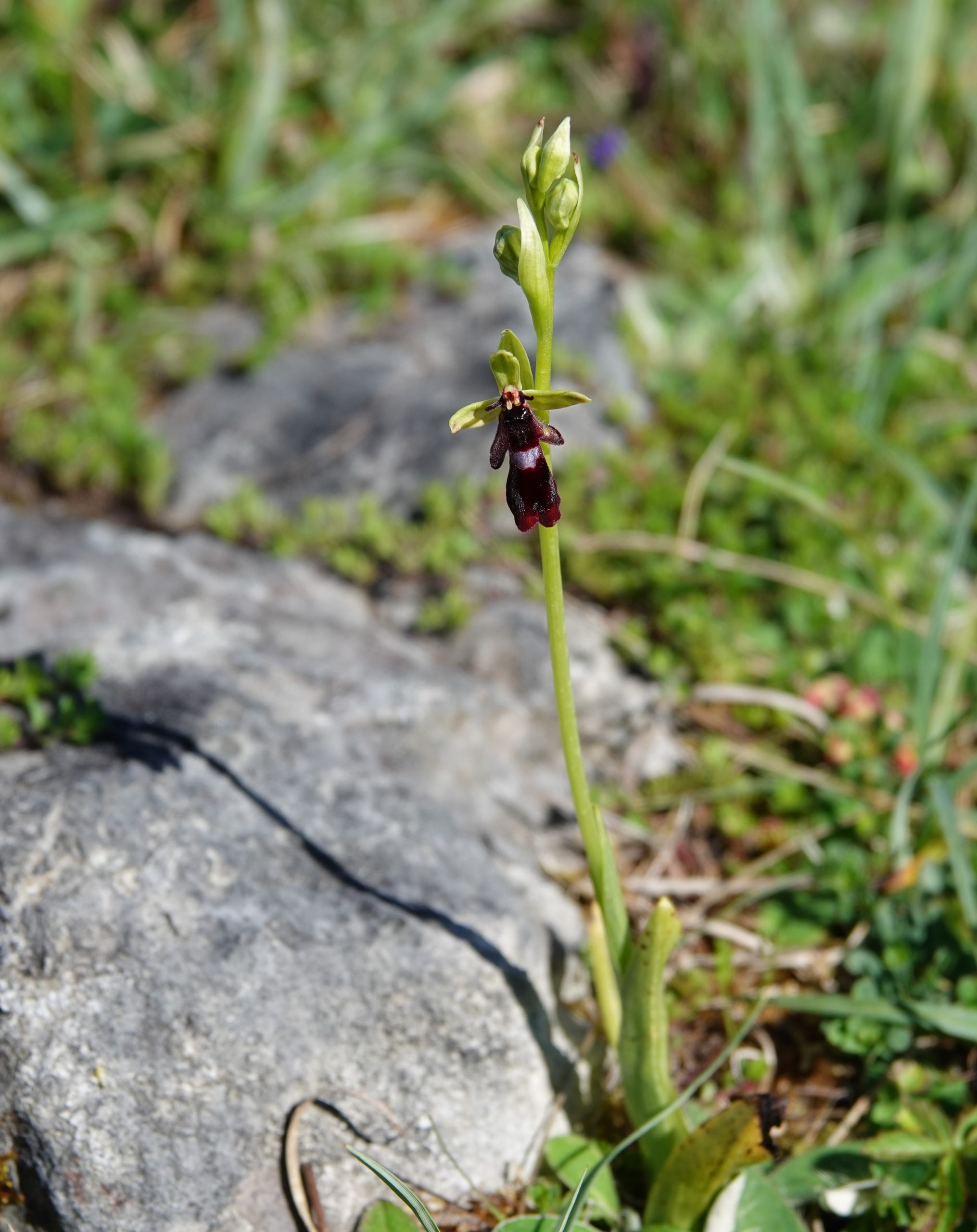
Ophrys insectifera (fly orchid)
As we continued our walk, the orchid meadow transitioned to hazel woodland. While the Burren is known for large expanses of limestone pavement, these woodlands are equally important biologically. This habitat is found only along the west coasts of Ireland and Scotland and they harbour an incredible diversity of lichens, fungi, and bryophytes. While hazel woodland only covers a small area of the Burren now, it was once the dominant habitat in this area. Human influence, particularly clearing of woodland and grazing by livestock, keeps woody plants from regenerating and maintains the open conditions dominating most of the landscape here.
Our afternoon walk culminated with an excellent view of one of the Burren’s most famous limestone hills, Mullaghmore.

Mullaghmore with large turlough Lake Gealain
This is the only hill in the national park where the limestone strata are folded, due to past volcanic activity in the vicinity. Lake Gealain in the foreground is a fine example of the temporary lakes called turloughs which are characteristic of the area. Turloughs fill up in the winter from underground springs, draining away either partially (in the case of Lake Gealain) or completely through the porous limestone in the summer. These turloughs have their own characteristic vegetation, including the rare shrubby cinquefoil (Dasiphora fruticosa) which grows at the winter high water mark. I also found an abundance of early marsh orchid (Dactylorhiza incarnata) around Lake Gealain. Interestingly, I saw both the spotted and unspotted leaf forms, sometimes regarding as separate subspecies, growing side by side.
Tuesday 24 May (Vida)
On our second day out on the Burren we headed to the coast at Poulsallagh to explore a classic limestone pavement site with Carl as our guide again.
Here the flat, barren limestone is split into blocks called ‘clints’ by deep fissures or grikes known locally as ‘scailps’. These scailps form by acidic rainwater that gradually dissolves the limestone along existing cracks. At this time of year, the scailps are full of blooming wildflowers, giving the appearance of a vast rock garden. Cheery yellow bird’s-foot trefoil (Lotus corniculatus) and bright pink bloody crane’s-bill (Geranium sanguineum) seem to spill out of the shallower crevices, while a variety of ferns including sea spleenwort (Asplenium marinum) and the delicate maidenhair fern (Adiantum capillus-veneris) shelter in the deeper crevices.
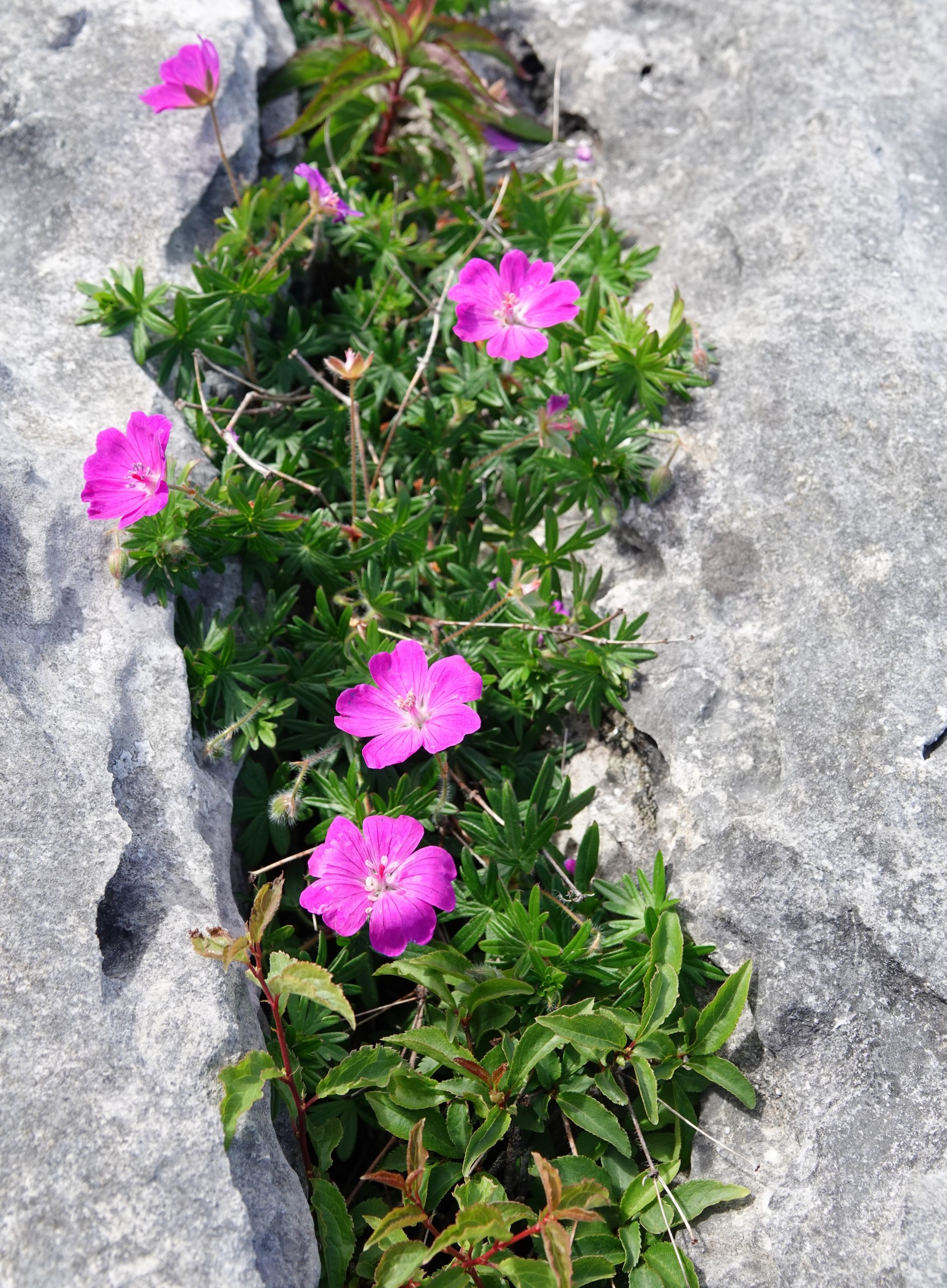
Geranium sanguineum in a limestone gryke
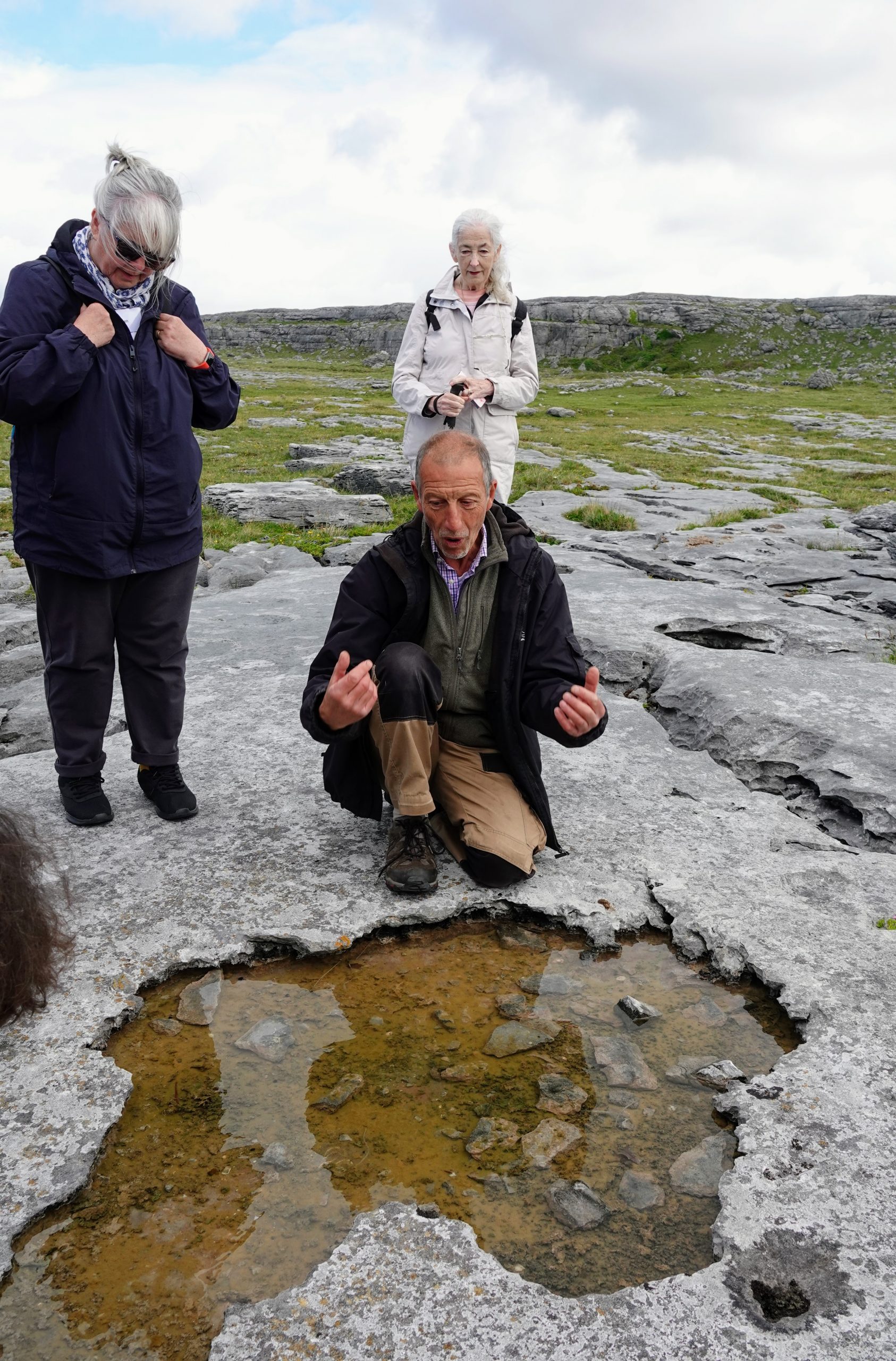
Carl explaining some limestone features
It was great fun peering into scailps and seeing what botanical marvels they held. As we explored, it seemed every few seconds someone would shout that they’d found some interesting plant hiding in a scailp! One exciting find was a pyramidal bugle (Ajuga pyramidalis) – a hairy, vaguely pyramidal relative of the common bugle which is a real rarity in Ireland.
My marsh orchid identification skills were really put to the test at Poulsallagh. Where peat has built up, heath-spotted orchid (Dactylorhiza maculata) was common – it was very strange to see this acid-loving plant growing on limestone. I was also excited to find Irish marsh orchid (Dactylorhiza majalis subsp. occidentalis), distinguished from the similar Dactylorhiza incarnata by its broad, flatter lip. The taxonomic status of Dactylorhiza majalis subsp. occidentalis is uncertain, but it is currently recognized as a subspecies endemic to Ireland.

Dactylorhiza majalis subsp. occidentalis, a supspecies endemic to Ireland
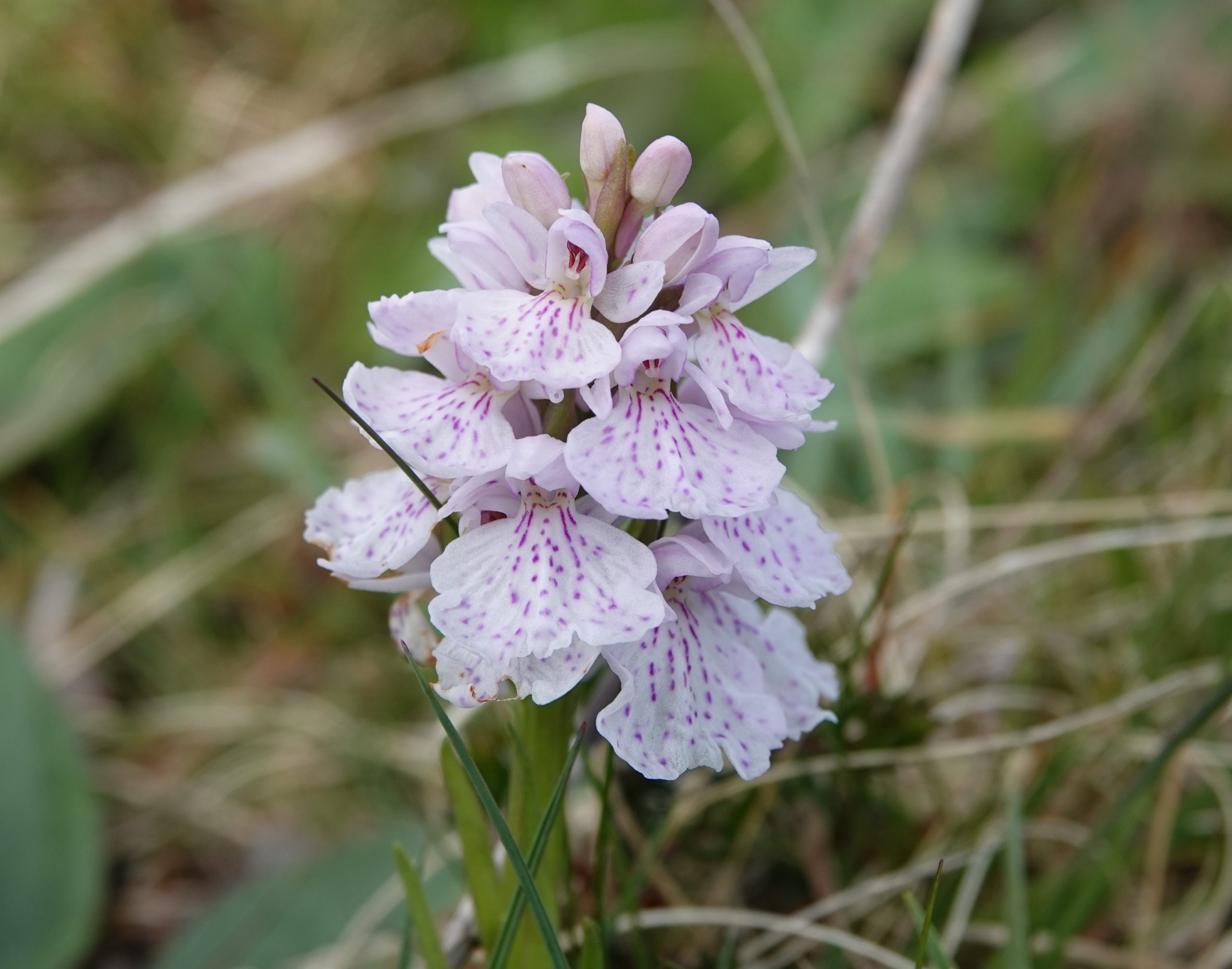
Dactylorhiza maculata (heath spotted orchid)
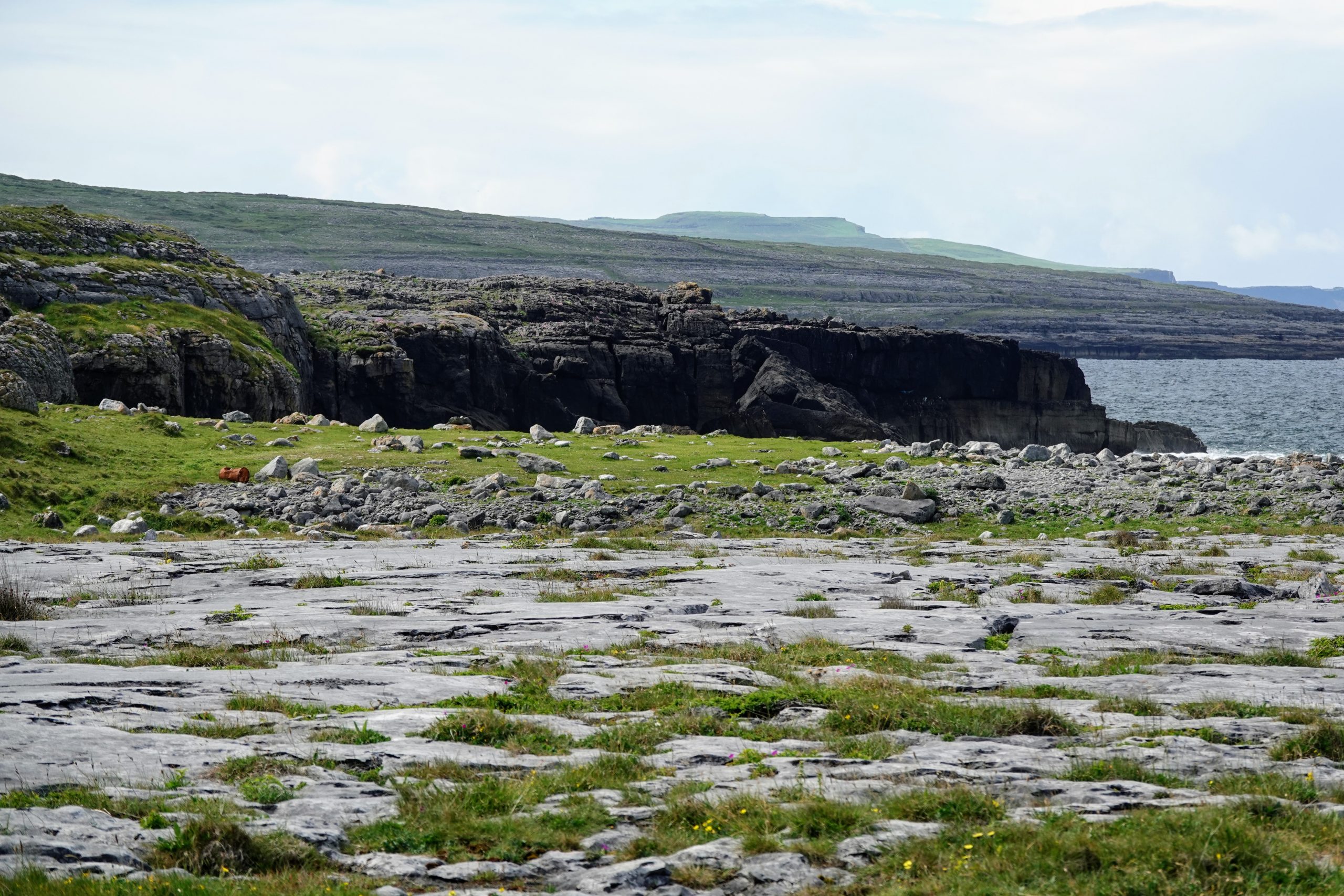
View from Poulsallagh
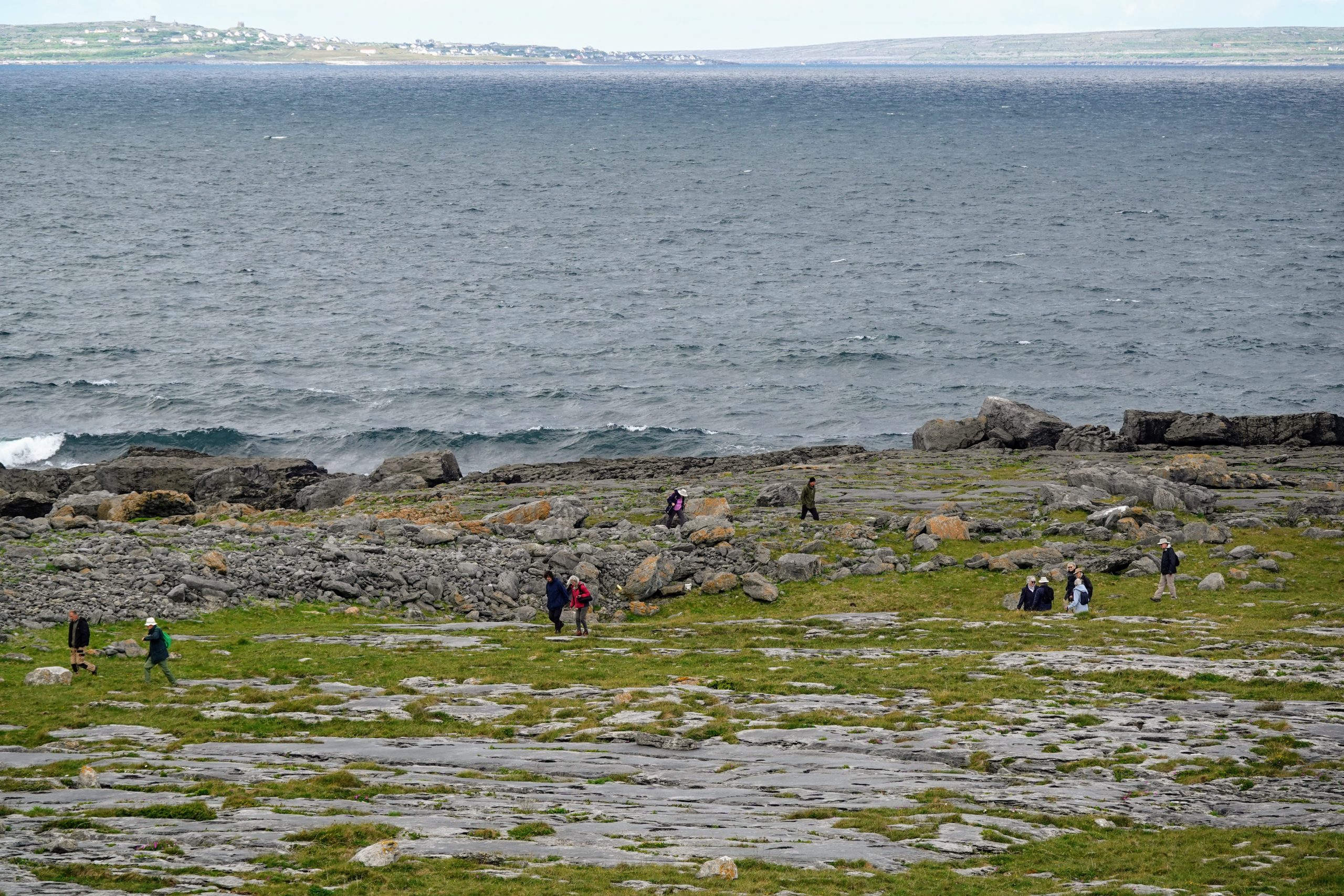
Exploring the limestone pavement flora, Poulsallagh
For lunch we visited the small town of Lisdoonvarna, then headed back to the coast just north of Fanore for further botanizing on the old coastal green road. Despite the cloudy weather, the views from here of the harsh limestone pavement extending all the way to the sea, with Galway Bay and the Farne islands in the distance, was spectacular.
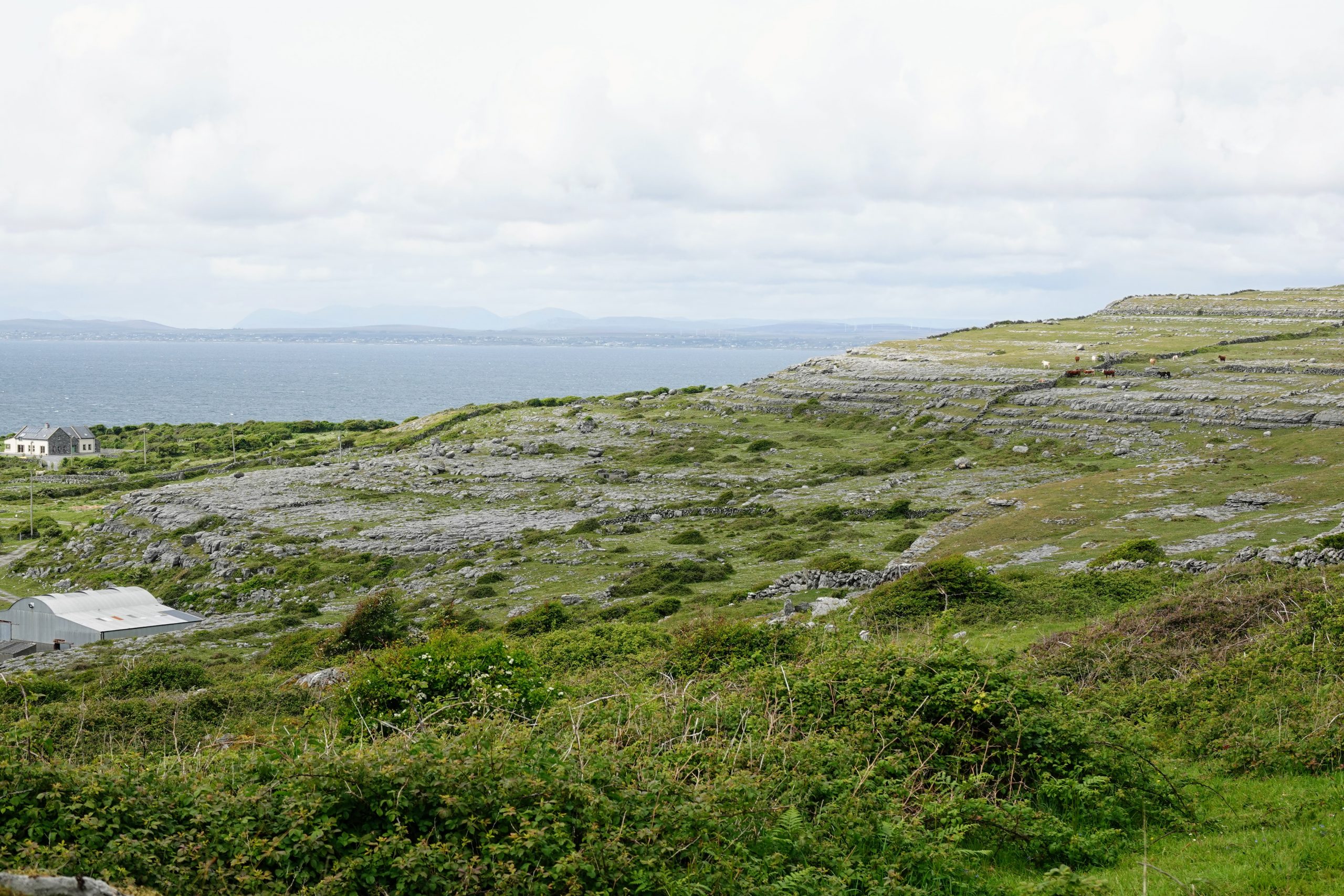
From old coastal green road
As the road climbed up the side of a hill, some of the rare wildflowers which had finished blooming at sea level became abundant, much to my delight. The tiny spring gentians (Gentiana verna), perhaps the most famous Burren flower, were such a stunning blue colour it was hard to look away. Spring gentians are one of several species found on the Burren’s limestone pavements which are usually associated with montane, alpine, or arctic plant communities. Others are mountain avens (Dryas octopetala) and Hoary Rock Rose (Helianthemum oelandicum subsp. piloselloides), both of which were blooming prolifically.
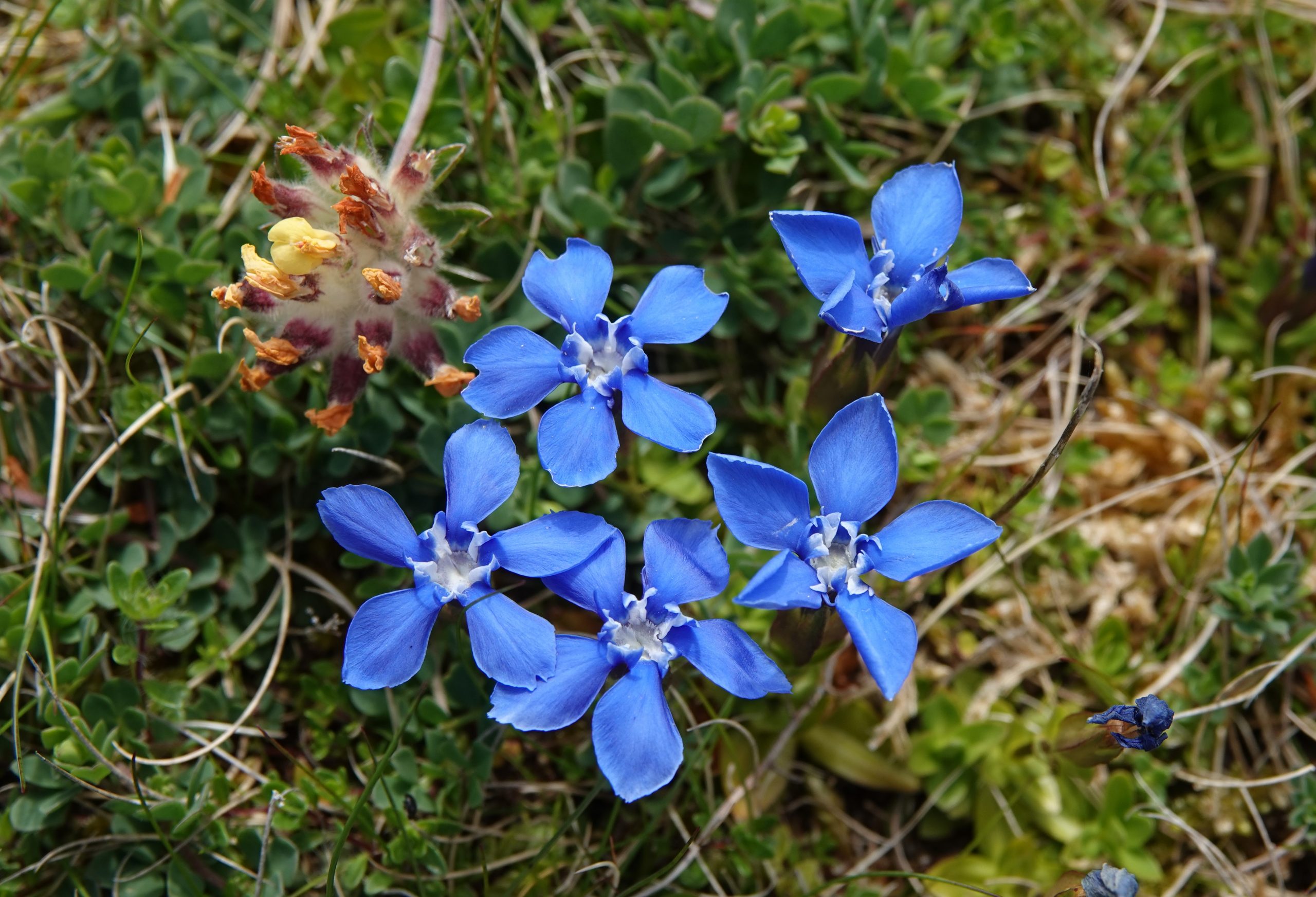
Gentiana verna
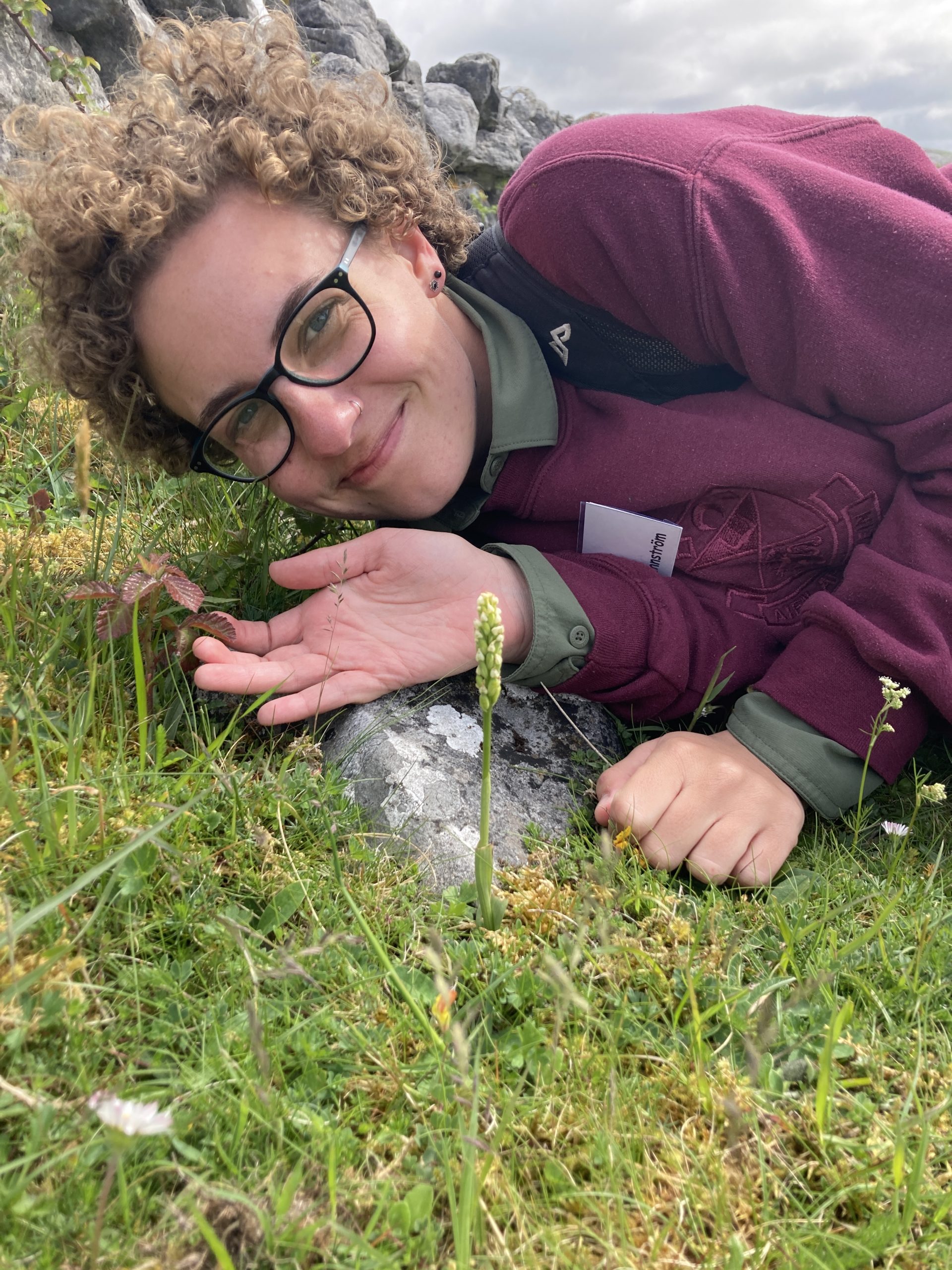
Vida with the rare Neotinea maculata
It was here that I found the rarest orchid of the trip, the dense-flowered orchid (Neotinea maculata). The small white flowers which were barely open won’t win any awards for their beauty, but as a lover of rare and weird plants, I was ecstatic to spot it. The strange thing about N. maculata is that while it is fairly widespread in the Mediterranean, the Burren is the only place you will find it in the British Isles, where it happily grows alongside alpine-arctic plants like Gentiana verna and Dryas octopetala.
Wednesday 25 May (Bridget)
After a hearty breakfast at the hotel, we drove to Ballynacourty in County Limerick, home of George and Michelina Stacpoole. I was struck by the lack of planting and horticultural interest in the gardens of the villages we passed – the trend was for hard landscaping paved driveways and grass strips – but luckily Ballynacourty bucked this trend.
An avenue of Tilia x europaea (lime) on the driveway led to the historic house where George met us. George was frank about his initial lack of gardening expertise when he set about creating the garden more than 53 years ago. He planted things he liked rather than for their suitability for the site and conditions, learning many lessons along the way. He fondly recalled the first tree he bought, a Salix from Woolworths. Ballynacourty sits on roughly 1.6 ha close to the Shannon and was originally open and exposed. Establishing shelter and privacy was a priority which led George to set about planting trees to create a series of interlinking garden rooms.
We went through a doorway hedge of Fagus sylvatica into a large open lawn with border beds and a Laburnum-covered walk underplanted with Lavandula. As George guided us further into the garden, there were striking sculptures, the work of young artists at Limerick School of Art and Design. George’s passion for antiques is evident throughout the garden with Greek amphoras, stone busts and antique arbors sitting in intimate nooks adding a sense of history and interest. We made our way into a clearing of meadow with a path mowed through.
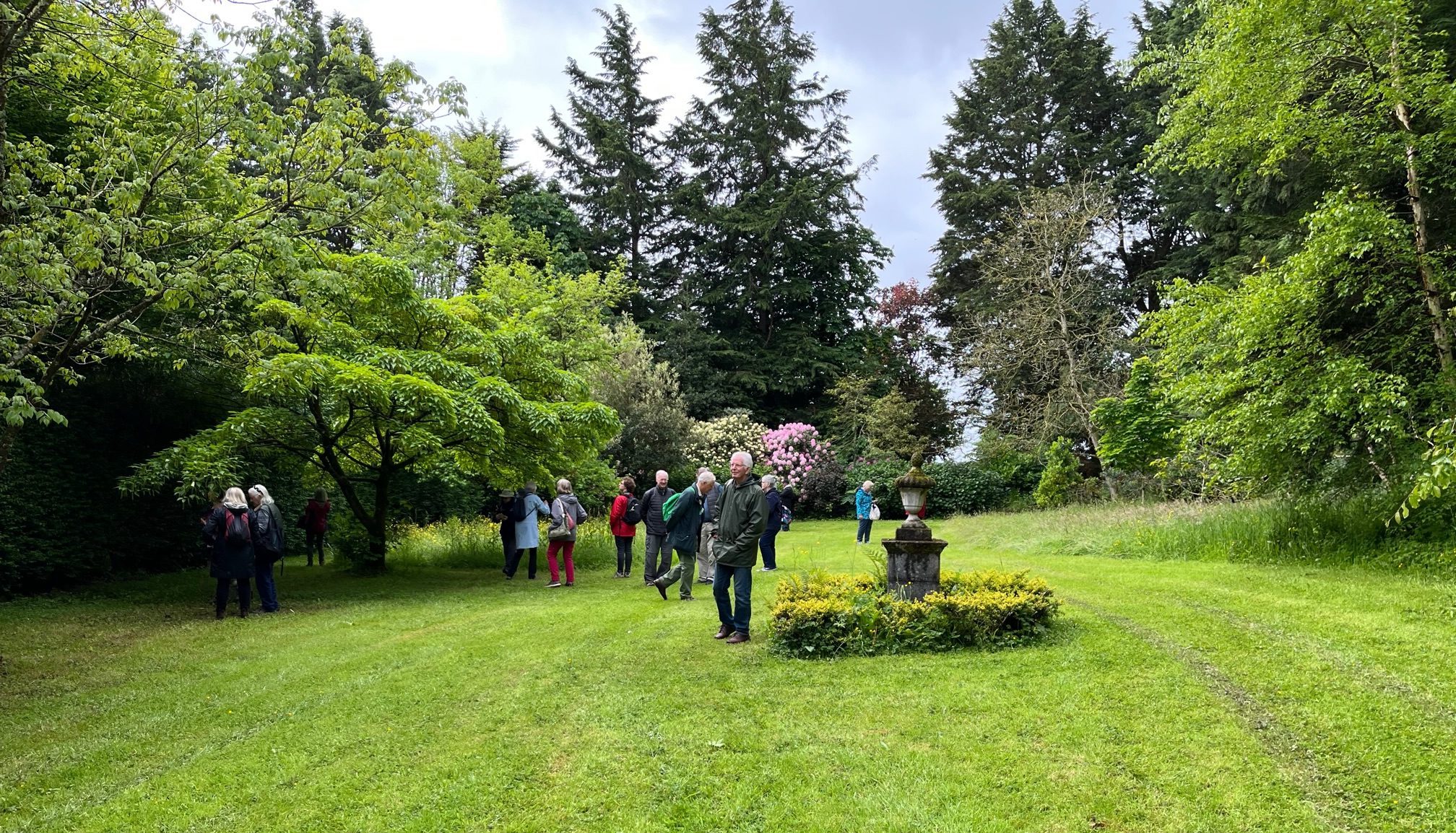
Established rhododendrons sat happily on the acidic clay. The maturity of the trees envelopes the space and creates a sense of quiet grandeur. An Acer davidii attracted interest from our group with its abundant pendulous flowers dangling from ovate leaves. Further trees of interest included Aesculus hippocastanum, Quercus robur, Fagus sylvatica ‘Purpurea’ and Acer palmatum. There was a sense of quiet confidence and classicism to the garden.
We made our way into a sunken parterre of loosely clipped Buxus sempervirens. A raised platform overlooking the parterre garden had two abundantly planted parallel beds of butterscotch orange Rosa ‘Inspiration’ and lilac pink old rose, Rosa ‘John Hopper’. Hemerocallis and purple lupins were in full bloom as well as pretty Primula pulverulenta and Primula japonica ‘Postford White’. Euphorbia mellifera spilled over the lichen-clad stone walls of the parterre and Dryopteris filix-mas crept out from beneath Italianate stone benches, whilst the backdrop of mature specimens of eucalyptus and pines added grandeur. Pathways of Rhododendron fauriei and Rhododendron x hybrid ‘Lees Dark Purple’, Rosa acicularis and Viburnum plicatum thrived in the boggy conditions with views leading out into the Limerick countryside.
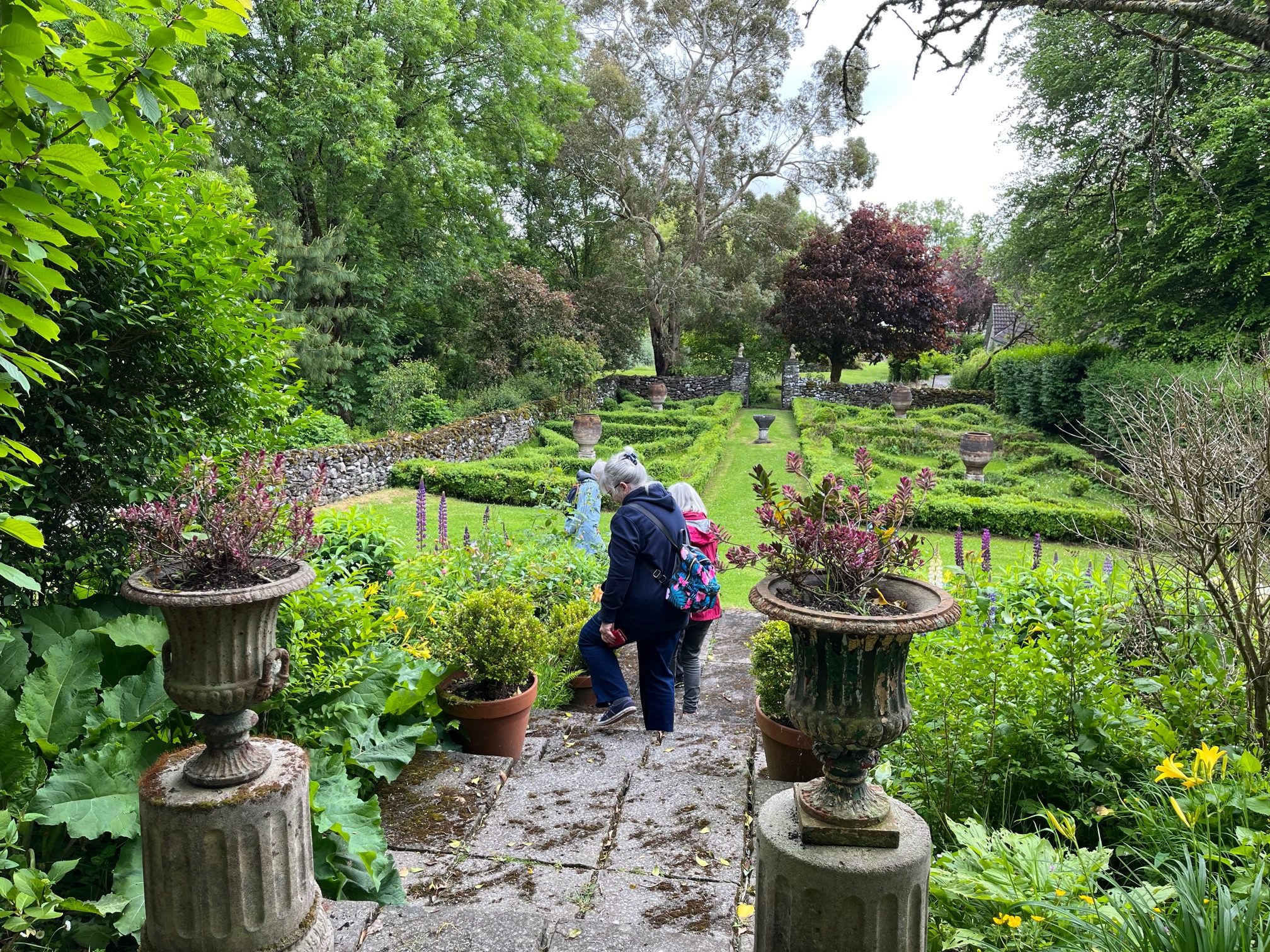
Ballynacourty Garden
We were graciously greeted by Michelina, George’s Italian wife in their elegant conservatory for tea served from a 19th century urn and delicious cakes.
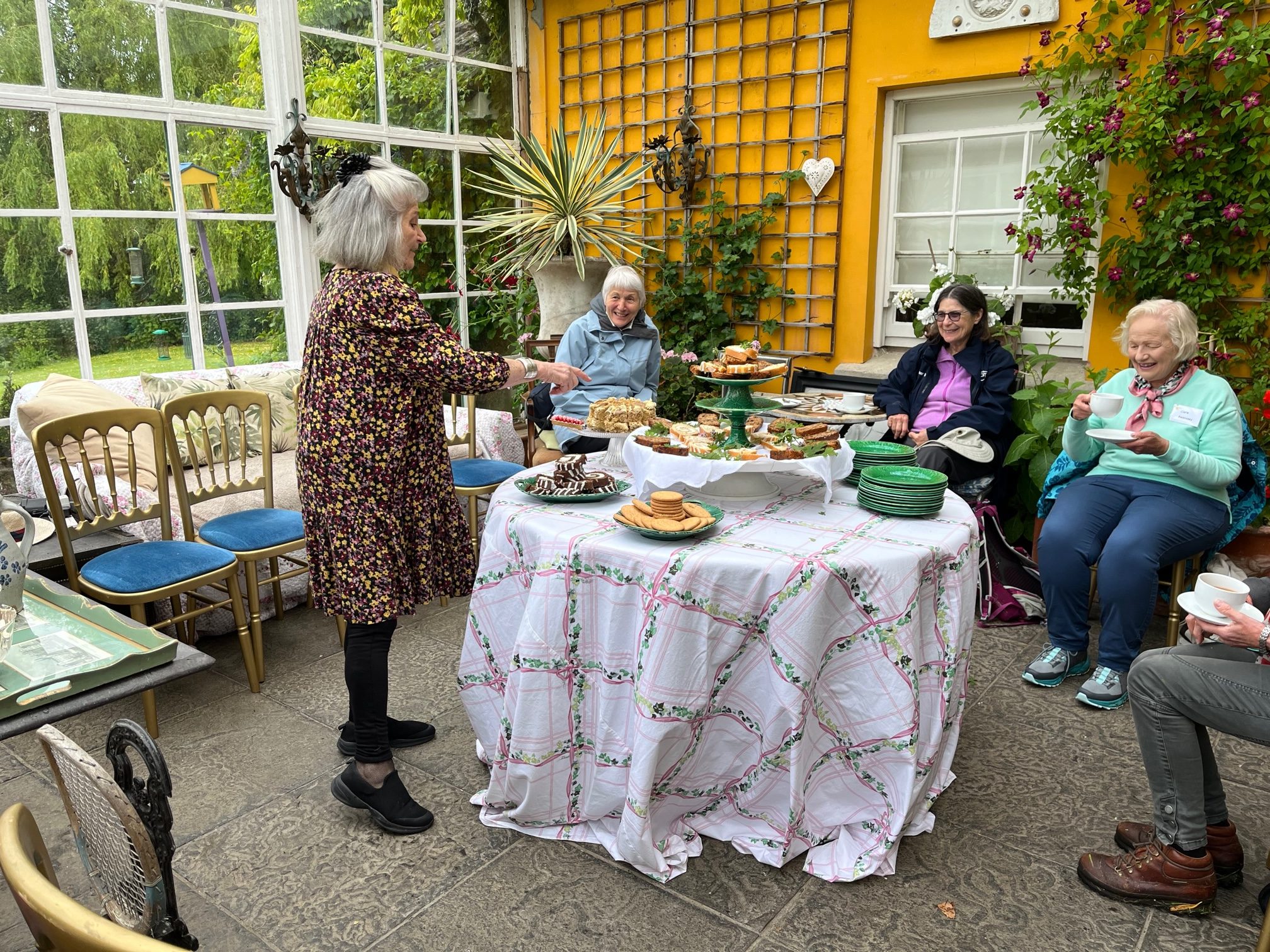
Following Ballynacourty, we moved on to Knockpatrick.

As we made our way up the lush driveway of Knockpatrick gardens we were warmly greeted by Helen and Tim O’Brien alongside their daughter Edel. The garden set in three acres of acidic to neutral soil is the creation of the O’Brien family.
Described as an Irish farmhouse garden it seemed to me so much more than that. There was an instant feel of the exotic with bursts of colour from fuchsia pink azaleas and rhododendrons lining the main drive. The garden was started by Tim’s father in the 1920s and has been lovingly curated by Tim and Helen, along with Edel. Magnolias, crinodendrons, beech and red horse chestnuts were established early in the garden’s development, offering shelter to more tender shrubs and plants.
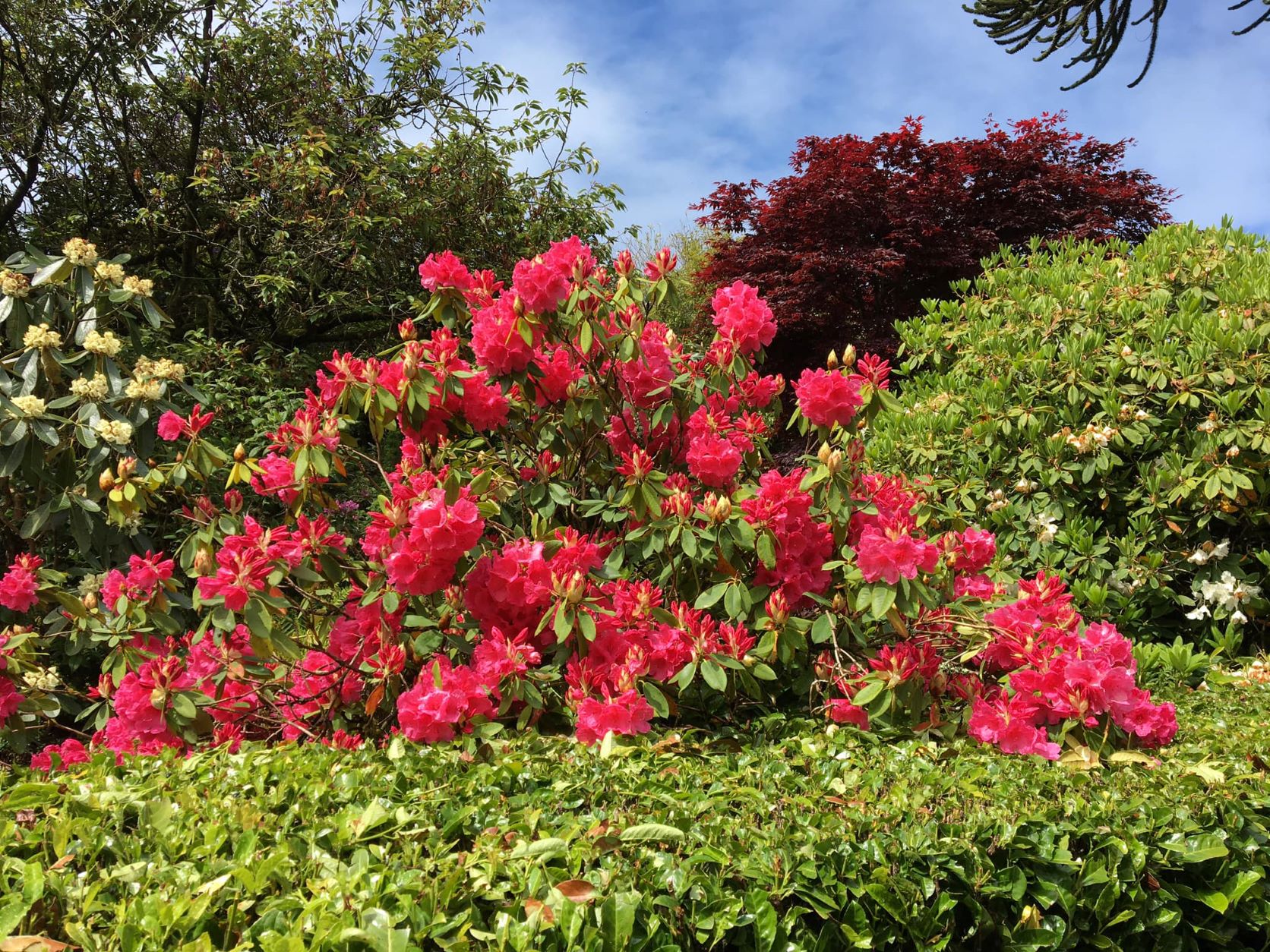
As we reached the main house and courtyard at the top of the drive, we followed a smaller pathway flanked by primula candelabras, hostas, ferns and echiums. I admired a flowering Abutilon x suntense with dark mauve petals and glossy maple foliage. The brimming foliage of the hostas and skunk cabbages were a pleasing backdrop to the delicacy of a Polygonatum x hybridum (Solomon’s seal) with its dangling clusters of small creamy white flowers.
The magenta lantern blooms of Tricuspidaria lanceolata stood out against the dark greens of leafy hostas, as did the Robinia pseudoacacia ‘Frisia’ with its bright yellow foliage.
The variety of forms and foliage from specimens such as Podophyllum versipelle ‘Spotty Dotty’ with its hexagonal and dappled green foliage. A variety of ferns were in abundance in the shadier areas and pleasing domes of Geranium maderense filled the beds closer to the house.
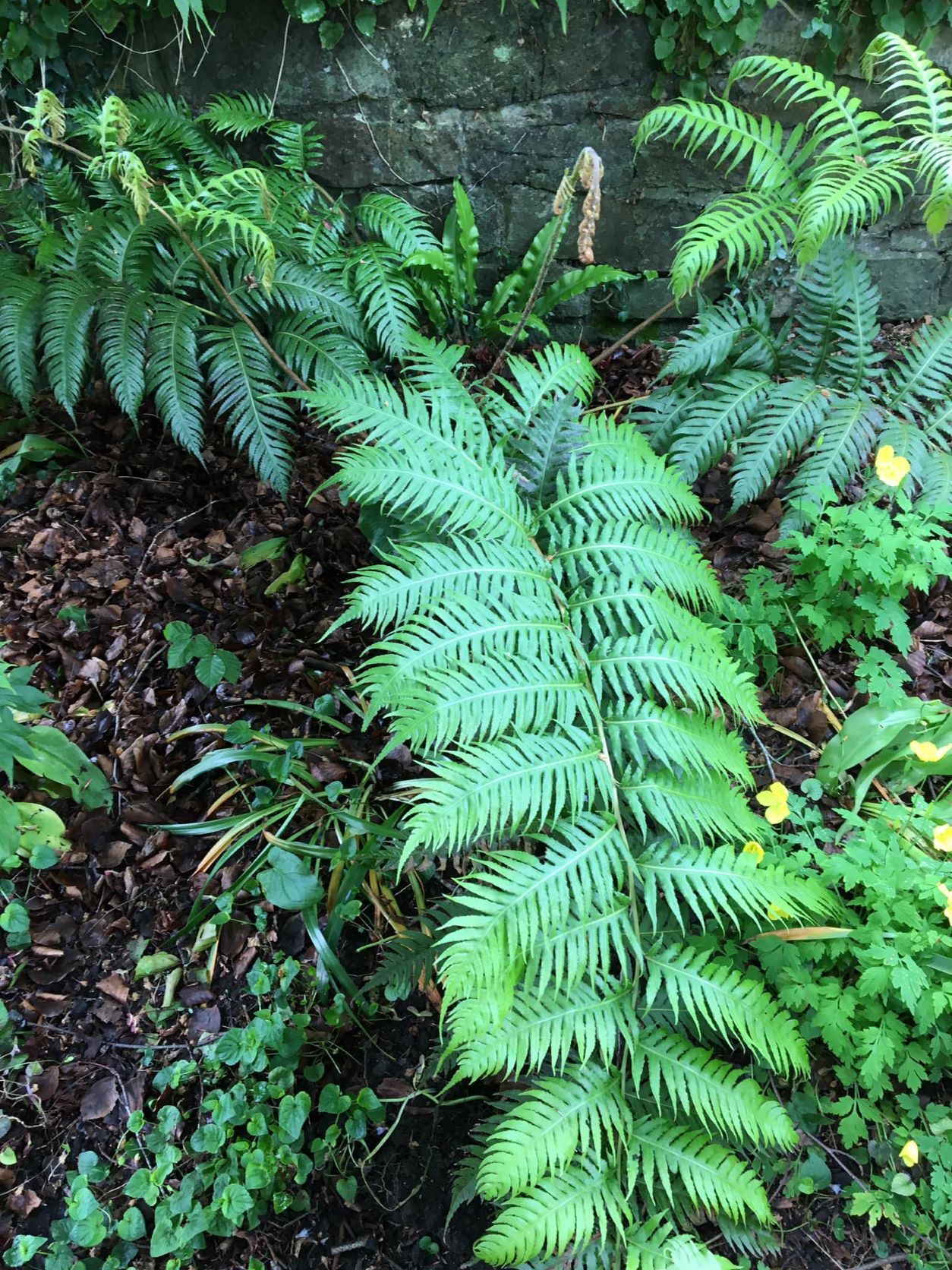
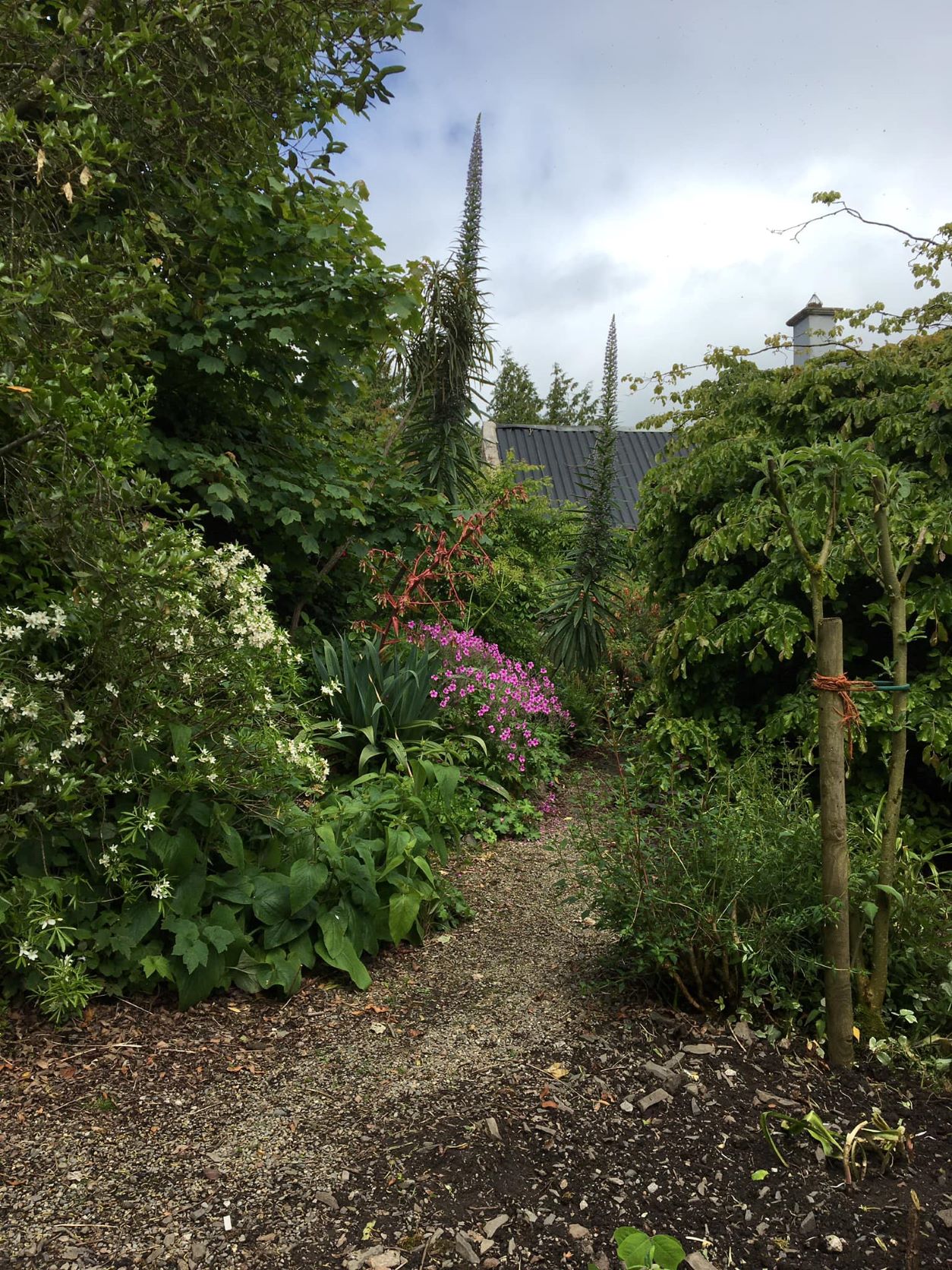
Continuing with the fiery colour palette, the brilliant red of the climbing Clianthus puniceus showcased the lobster-claw-shaped flowers beautifully. A more cottage garden feel wrapped around the house with views towards Limerick city. A verandah gave us a bird’s eye view over the other parts of the garden with shrubs, roses and rhododendrons in the foreground.
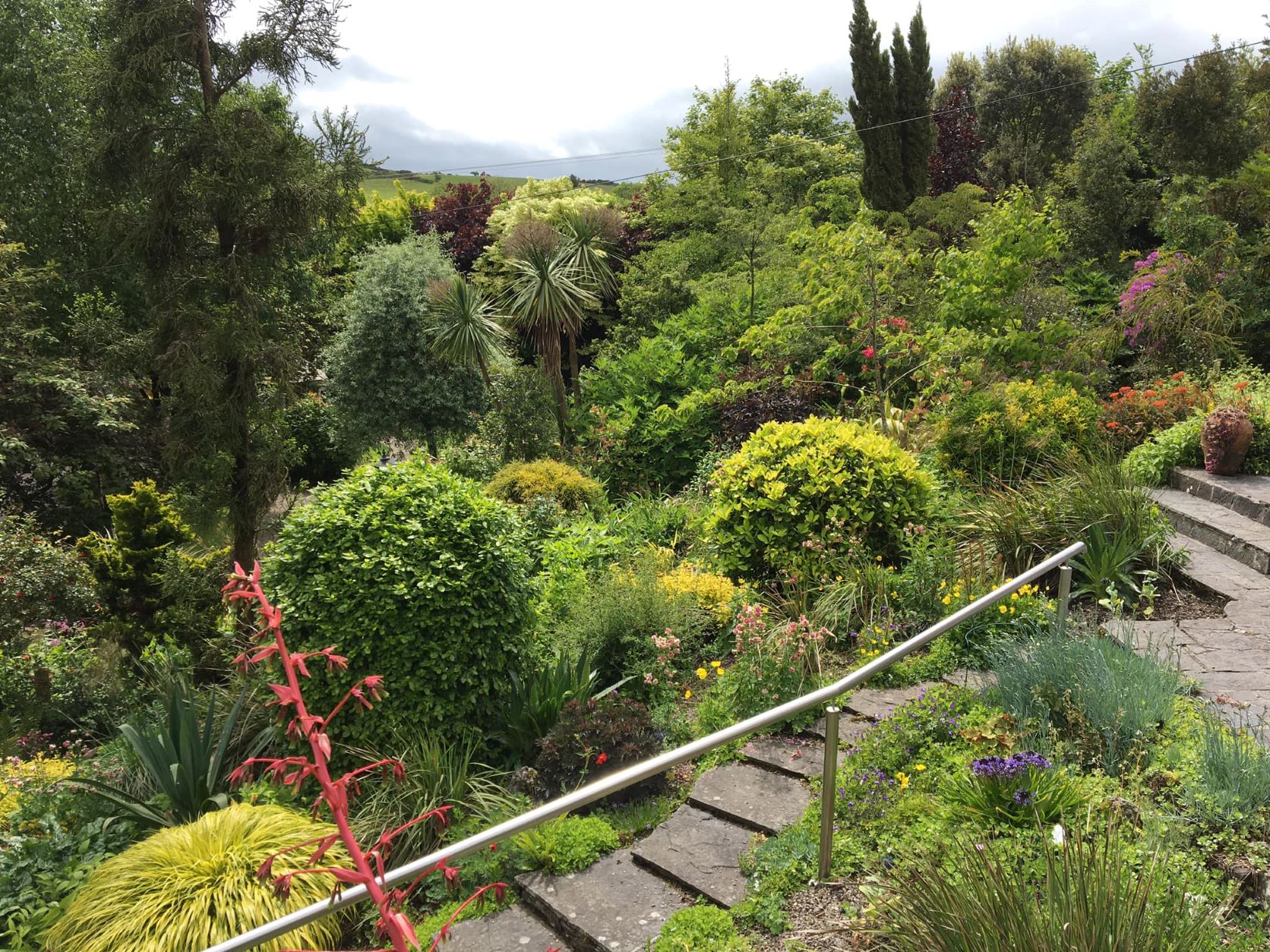
We were running a little behind schedule so left Knockpatrick wishing we could have had a little longer there, heading back east in the direction of Limerick, but stopped for a delicious light lunch at John Quinn’s De Bucket, a characterful restaurant beside a small river.
We spent the afternoon in the charming Mediterranean-style garden of Val and Jim Dennison in the nearby village of Kildimo. Both Val and Jim are artists and designers; Val is a prize-winning photographer and loves ferns. Their challenge had been combining two gardens when they were able to buy some adjacent land a few years ago, and Jim explained how they had approached this.
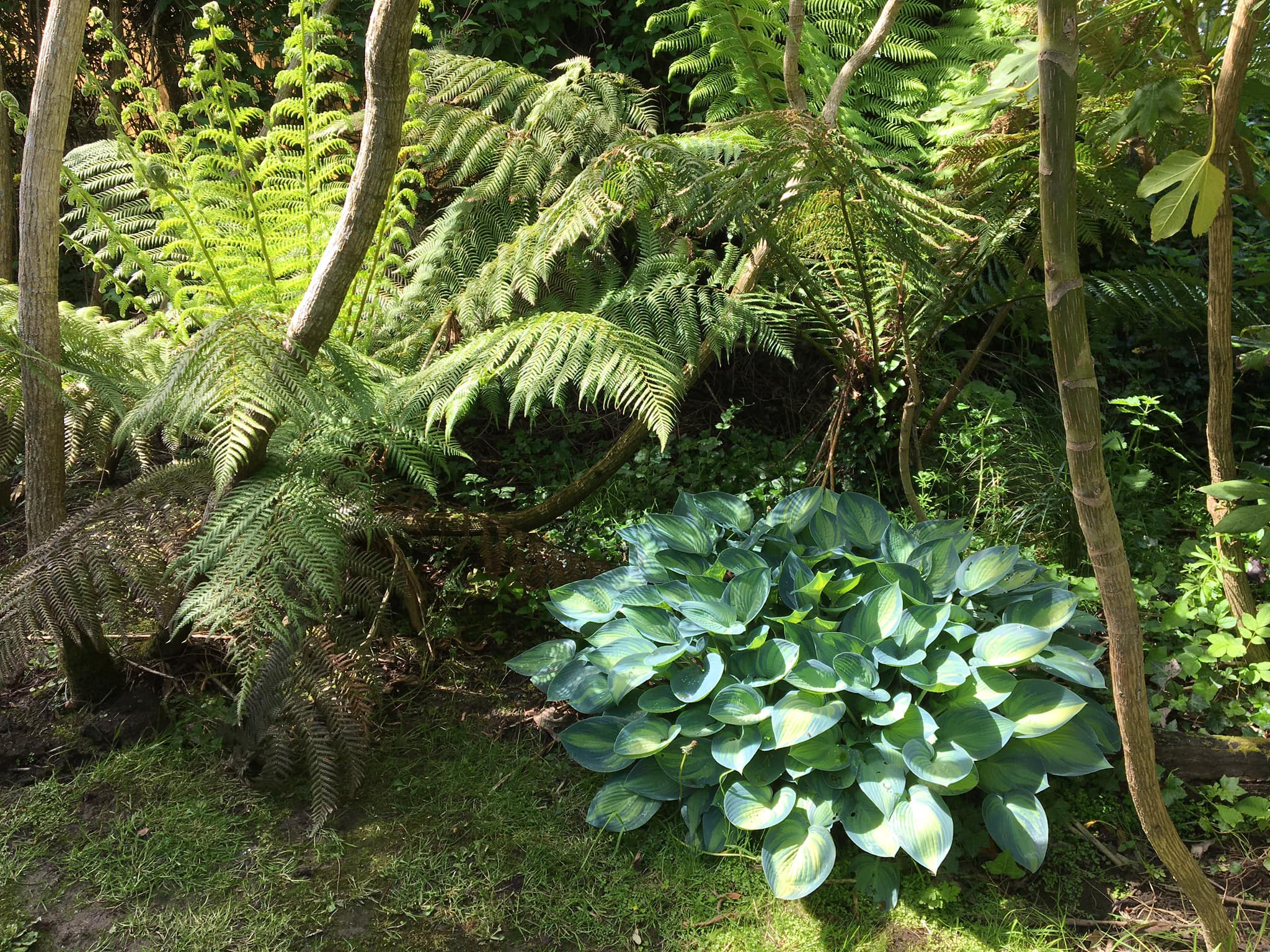
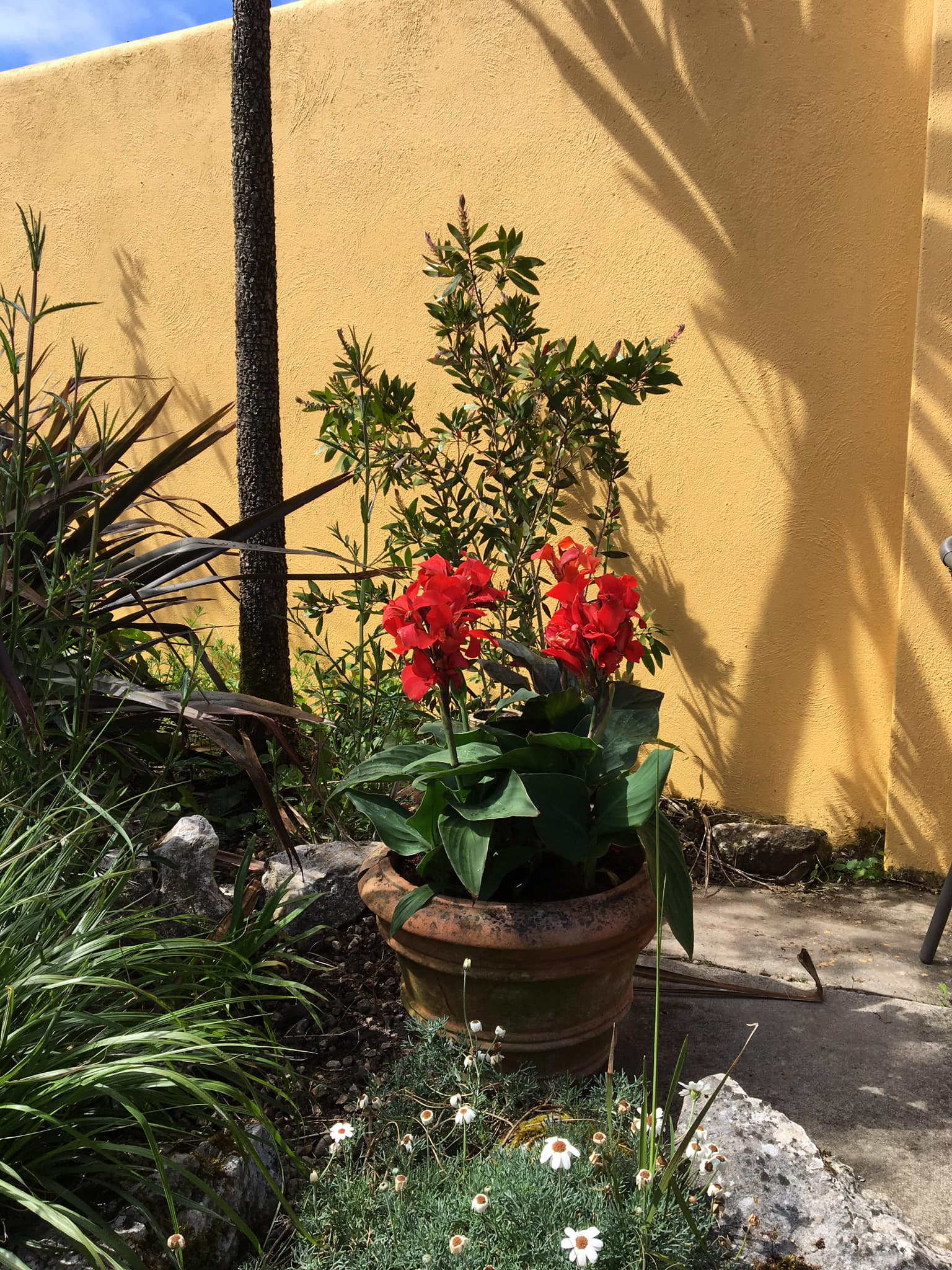
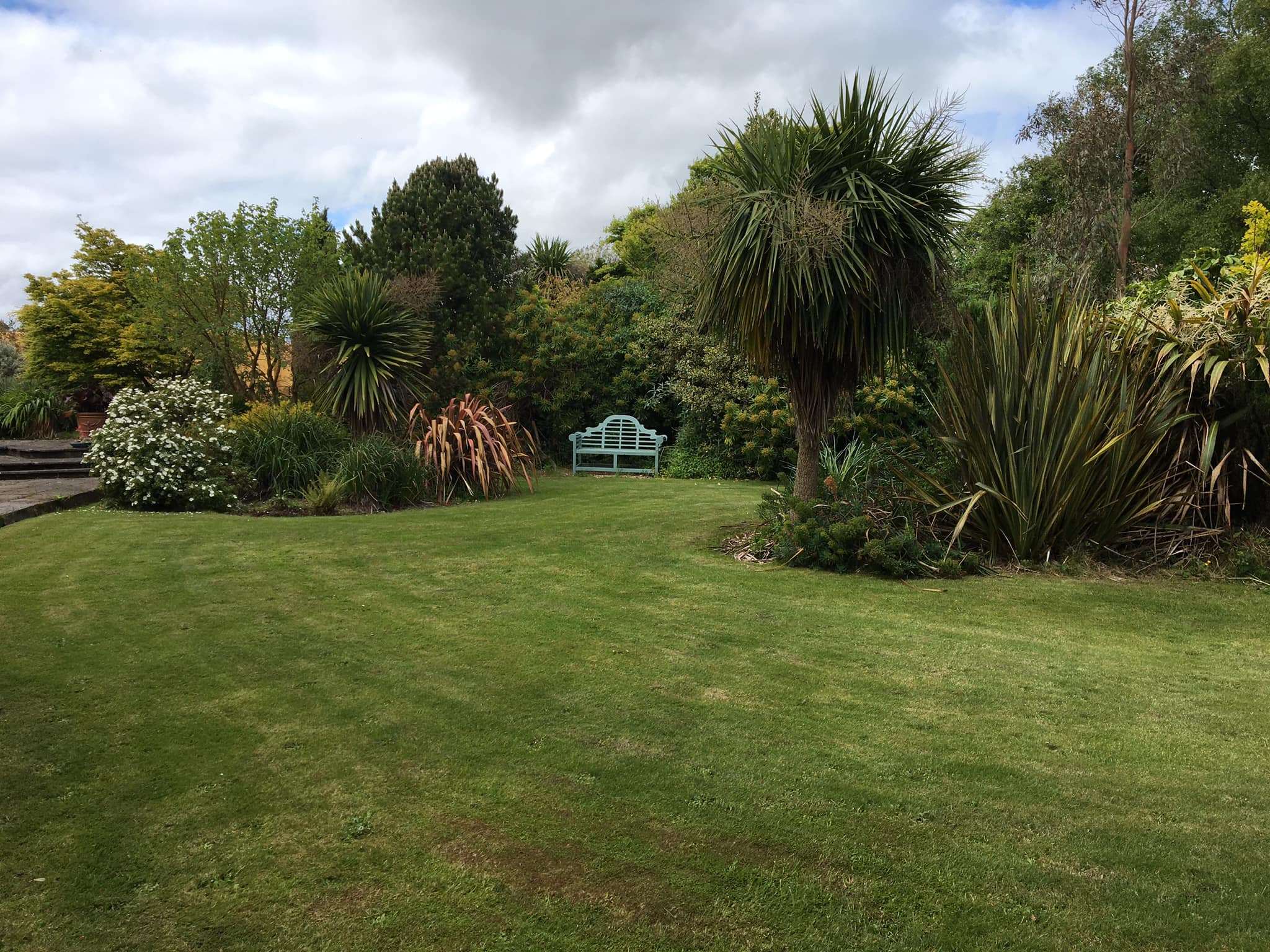
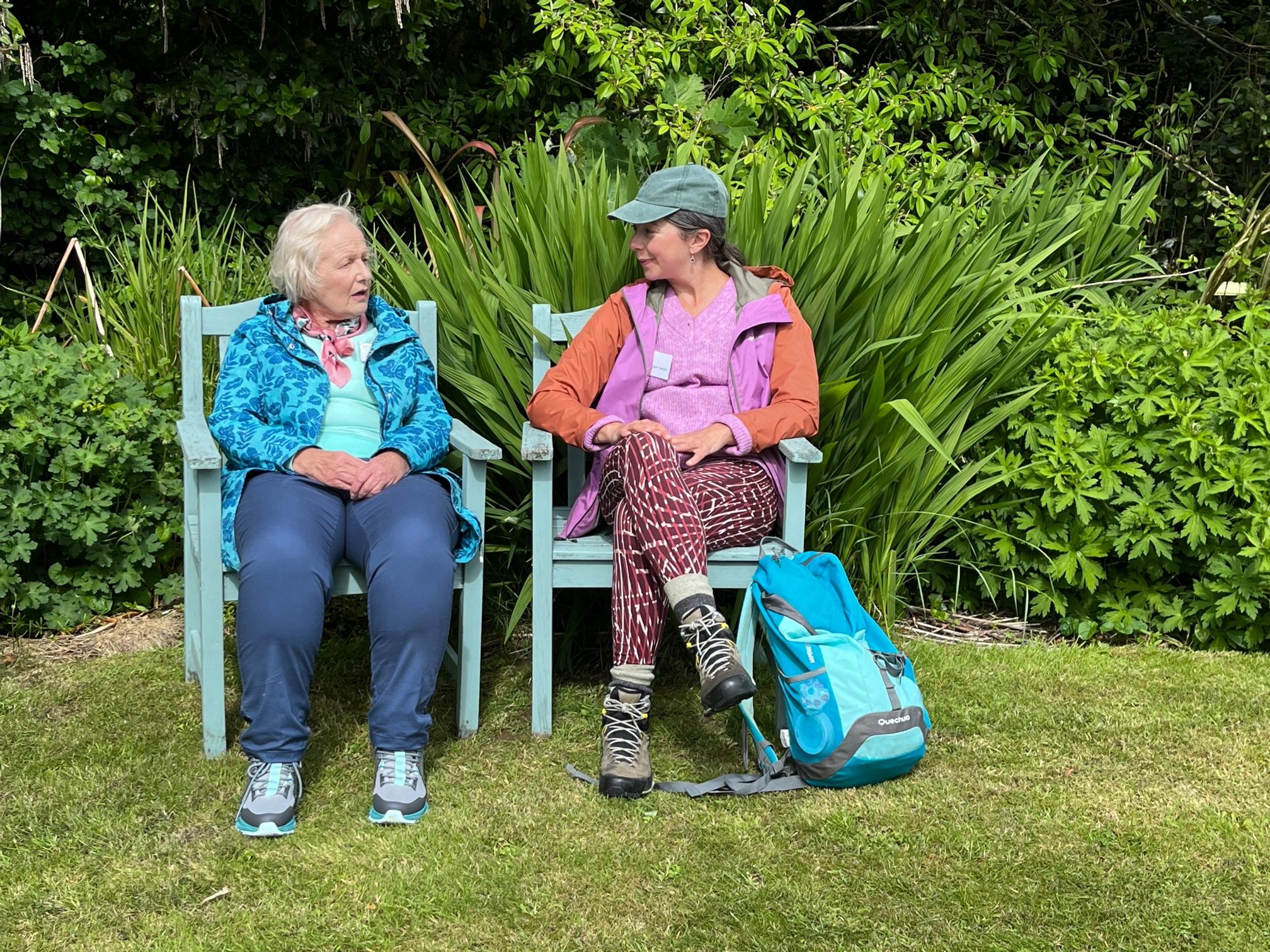
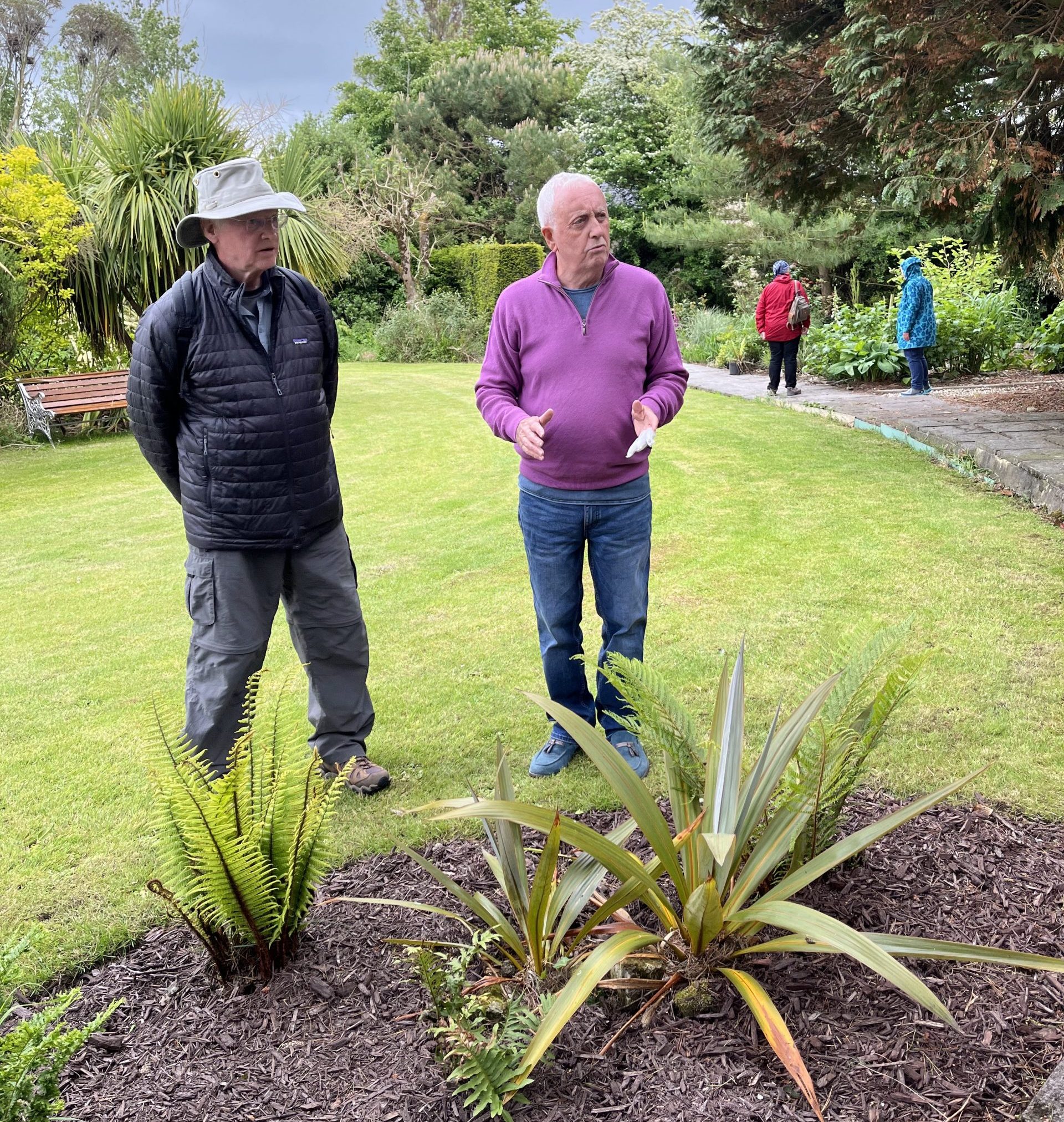
Members enjoying the afternoon at Kildimo garden
Thursday 26 May (Heather)
Drizzly weather on the morning of the last day was well timed as we were under cover more than on other days. In the morning we had a short visit to Bunratty Castle, which dates from the 13th century and has been developed for tourism in the past 60 years. We heard from the garden manager, Elaine Hiney-Wall, about the challenge of reopening after neglect and lost income during the Covid lockdowns, visited the walled garden, and saw a restored old farmhouse with stone slab wall, a water mill and remodelled village shops.
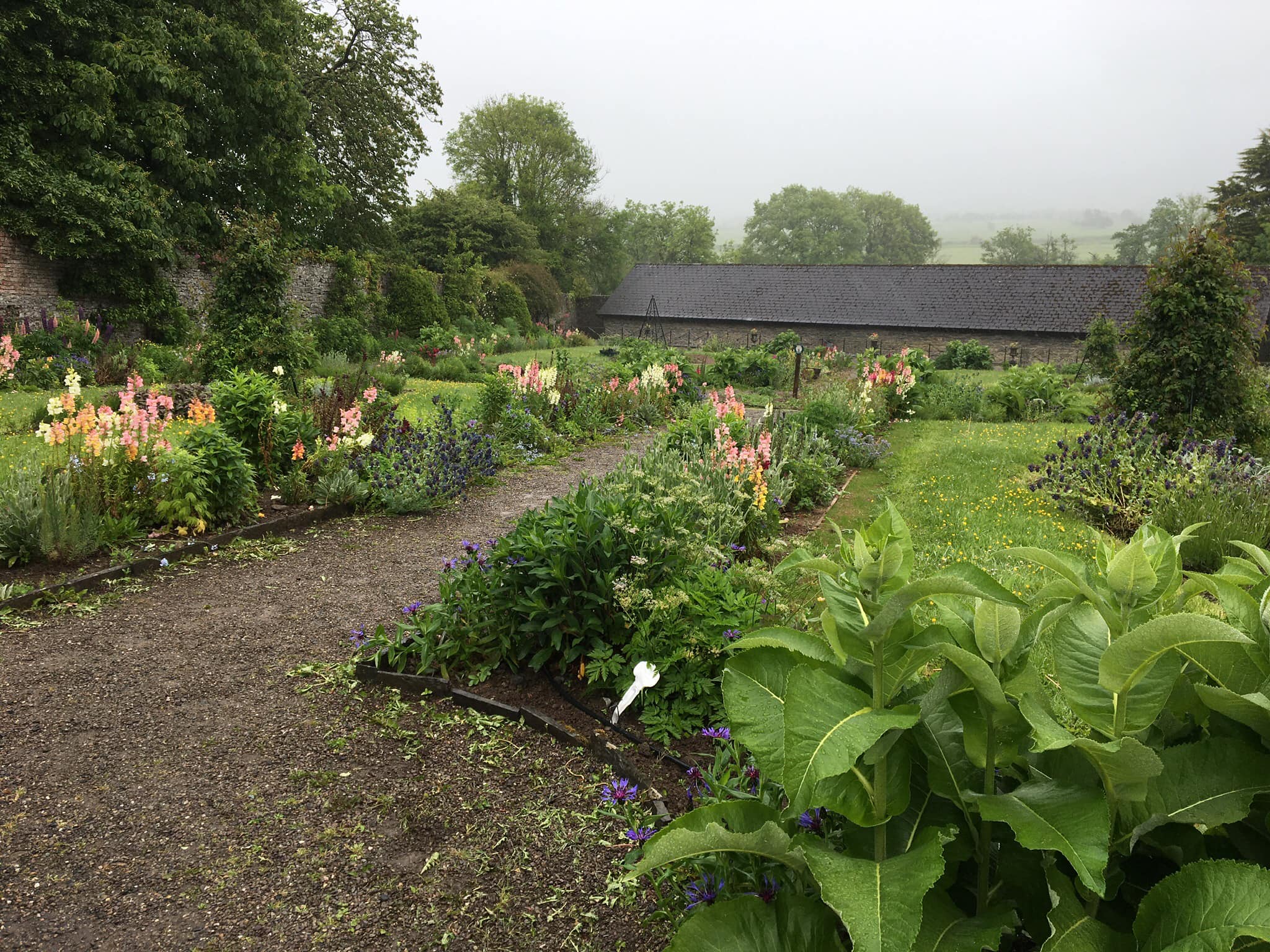
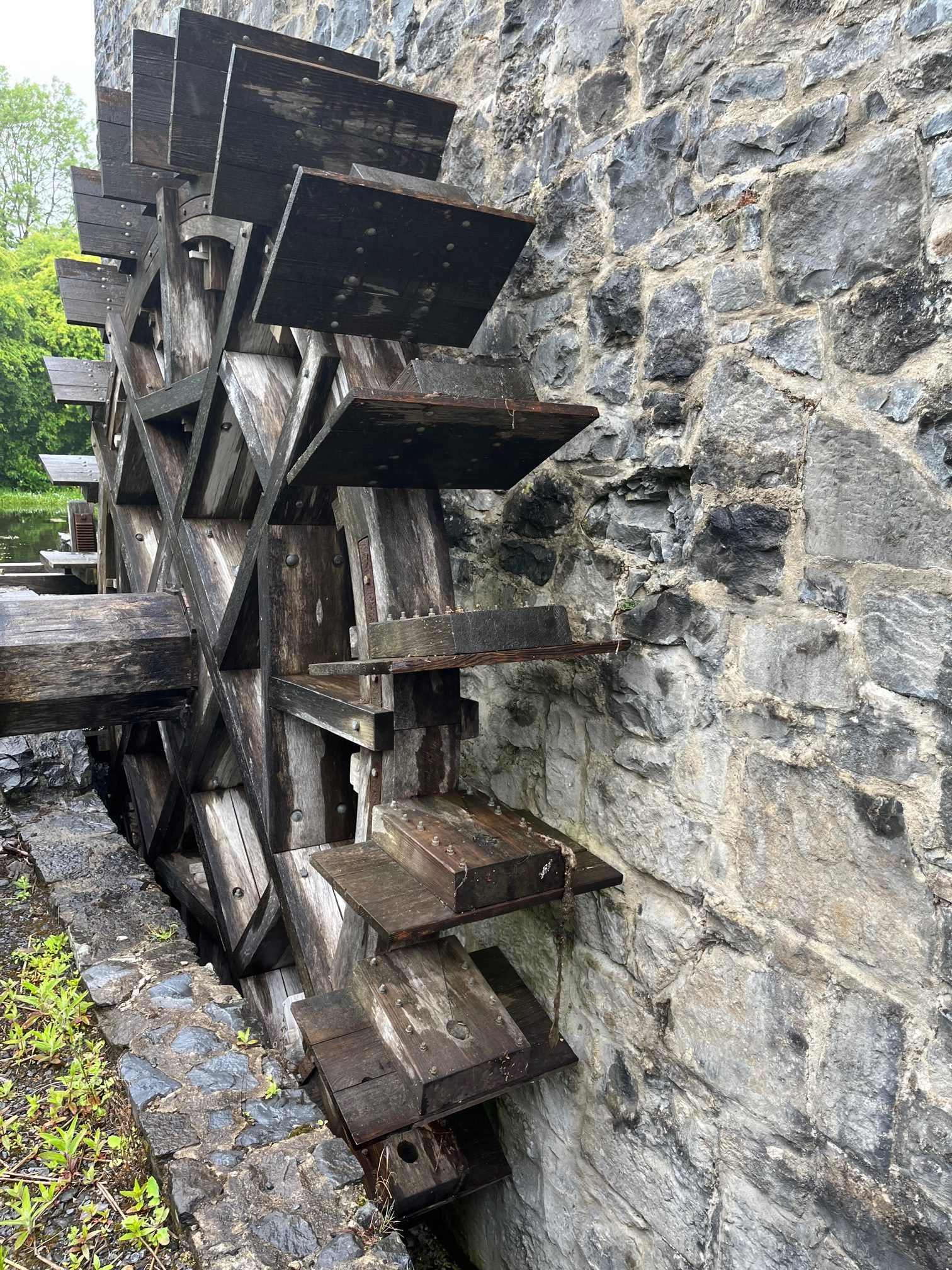
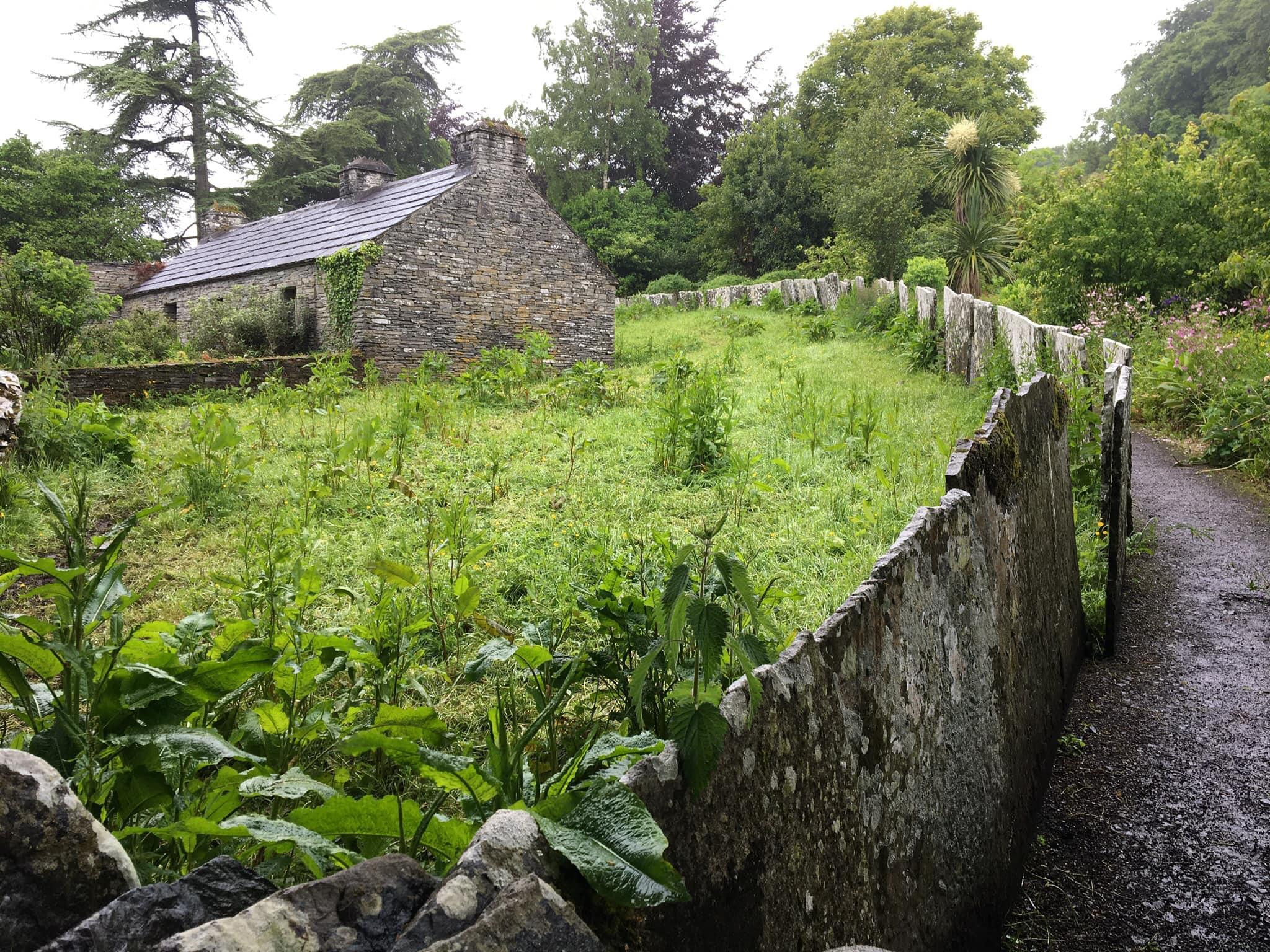
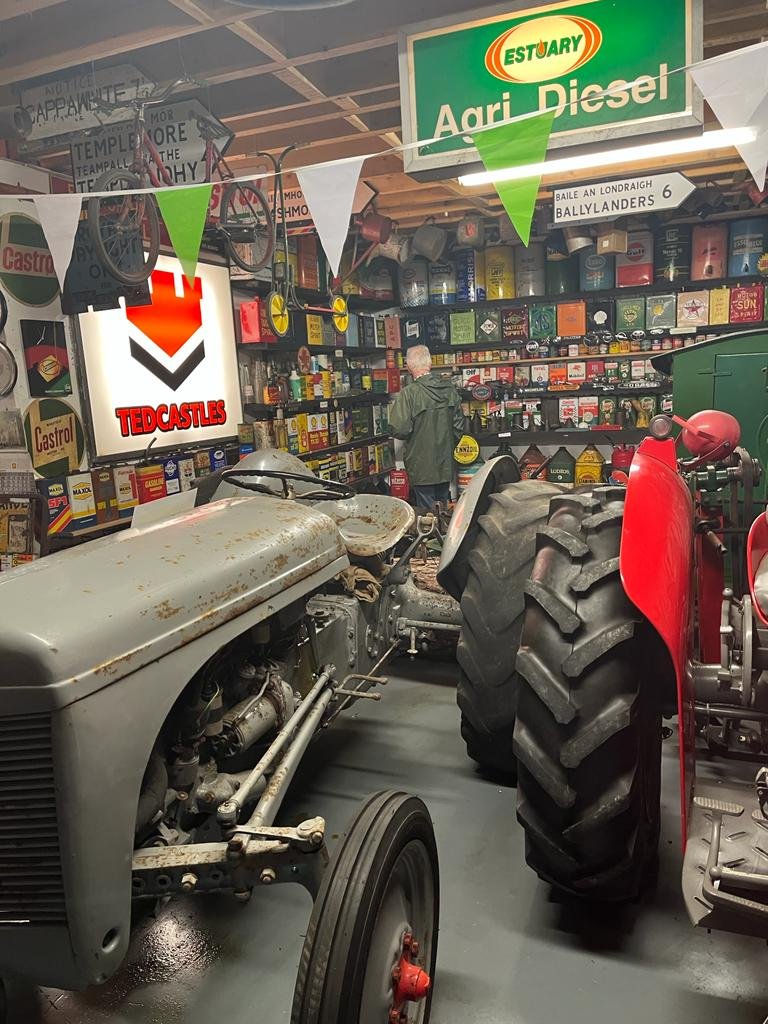
Our second stop was at Old Irish Ways Museum, an eclectic collection of artifacts ranging from old tractors, to telephones, branded tins and boxes of long-gone groceries, and prototype domestic tools such as a 120-year-old mechanised apple peeler.
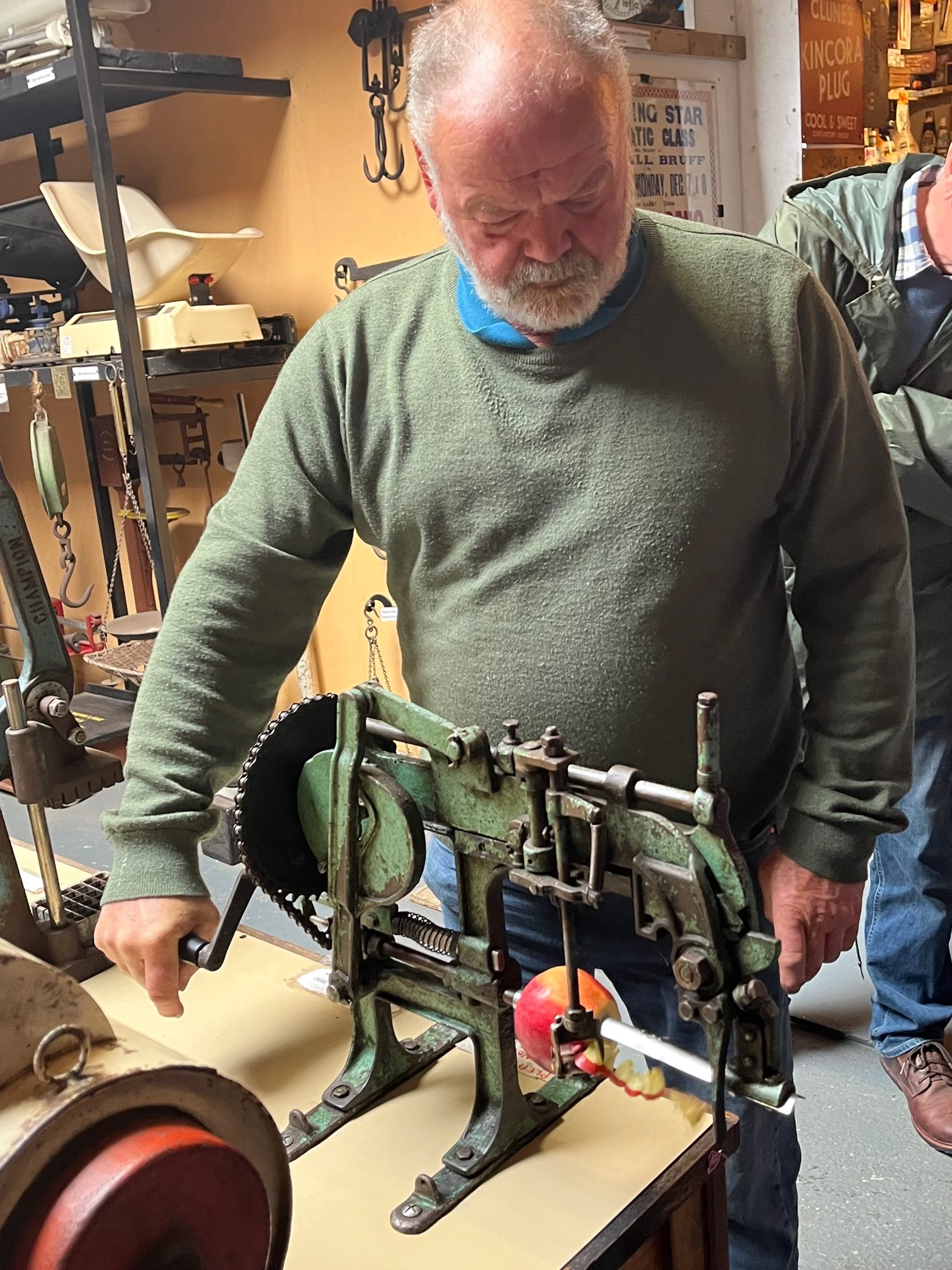
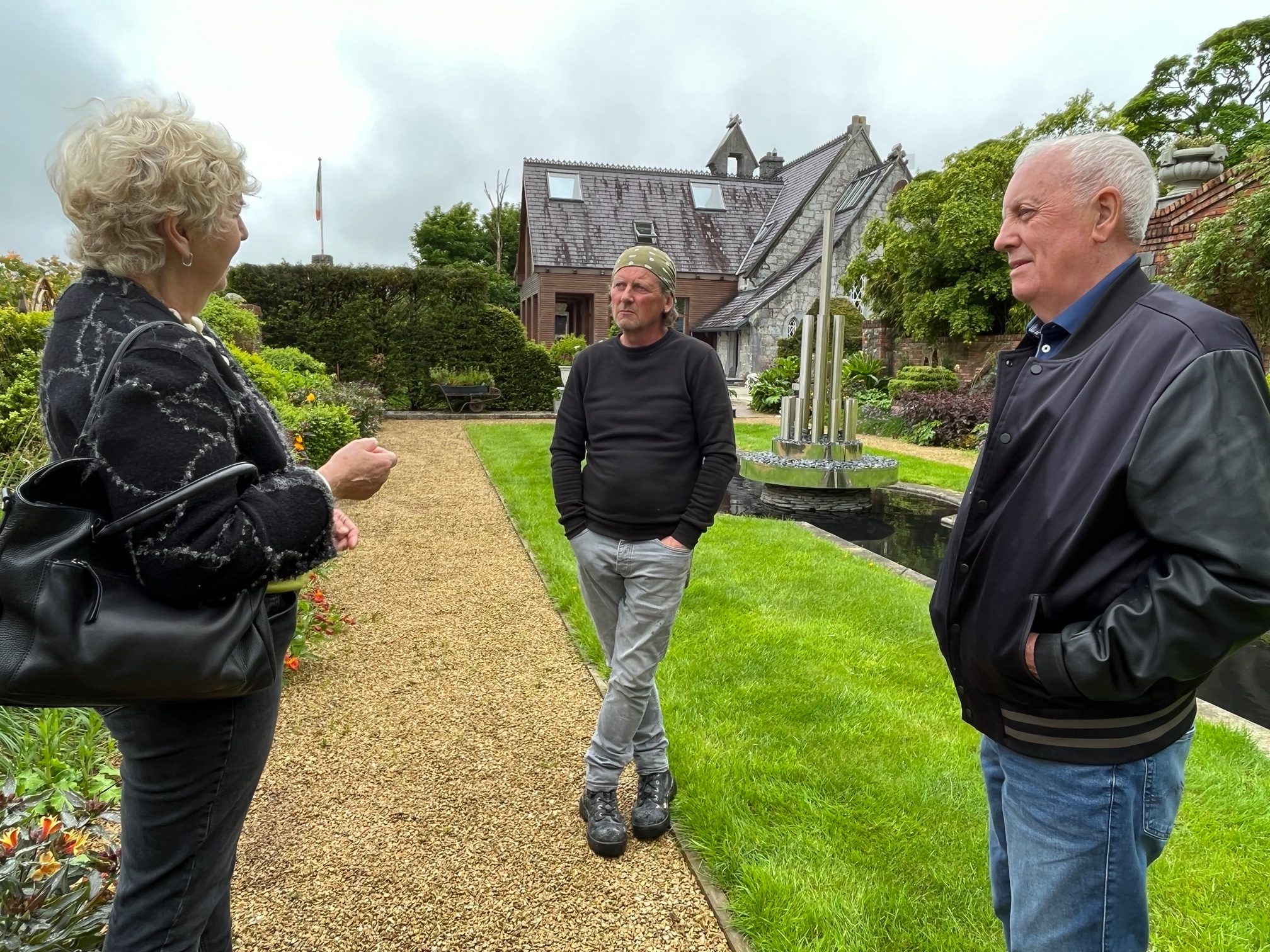
Val Dennison, Des Kingston, Jim Dennison
From there we continued to a soup-and-sandwich lunch on Ballyneety golf course, where we were joined by Val and Jim Dennison for the afternoon.
The sun came out for our afternoon visits. Cahernorry church, built in 1809, has been converted to the family home of Des Kingston, a garden designer by profession who chatted and explained as he showed us round his one-acre garden which contains statuary, topiary, formal and informal ponds, a tower, a large lawn and several amusing quirks.
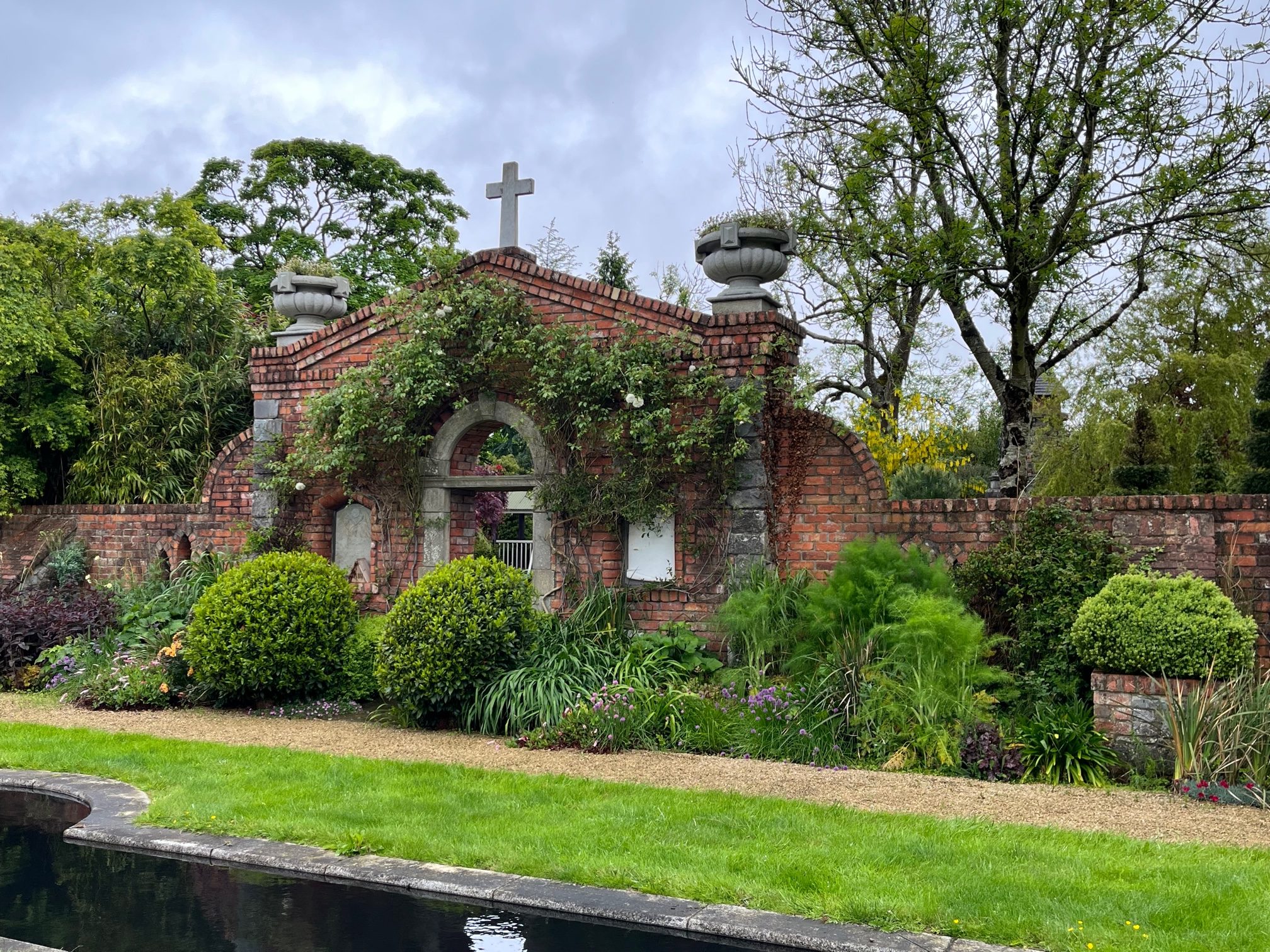
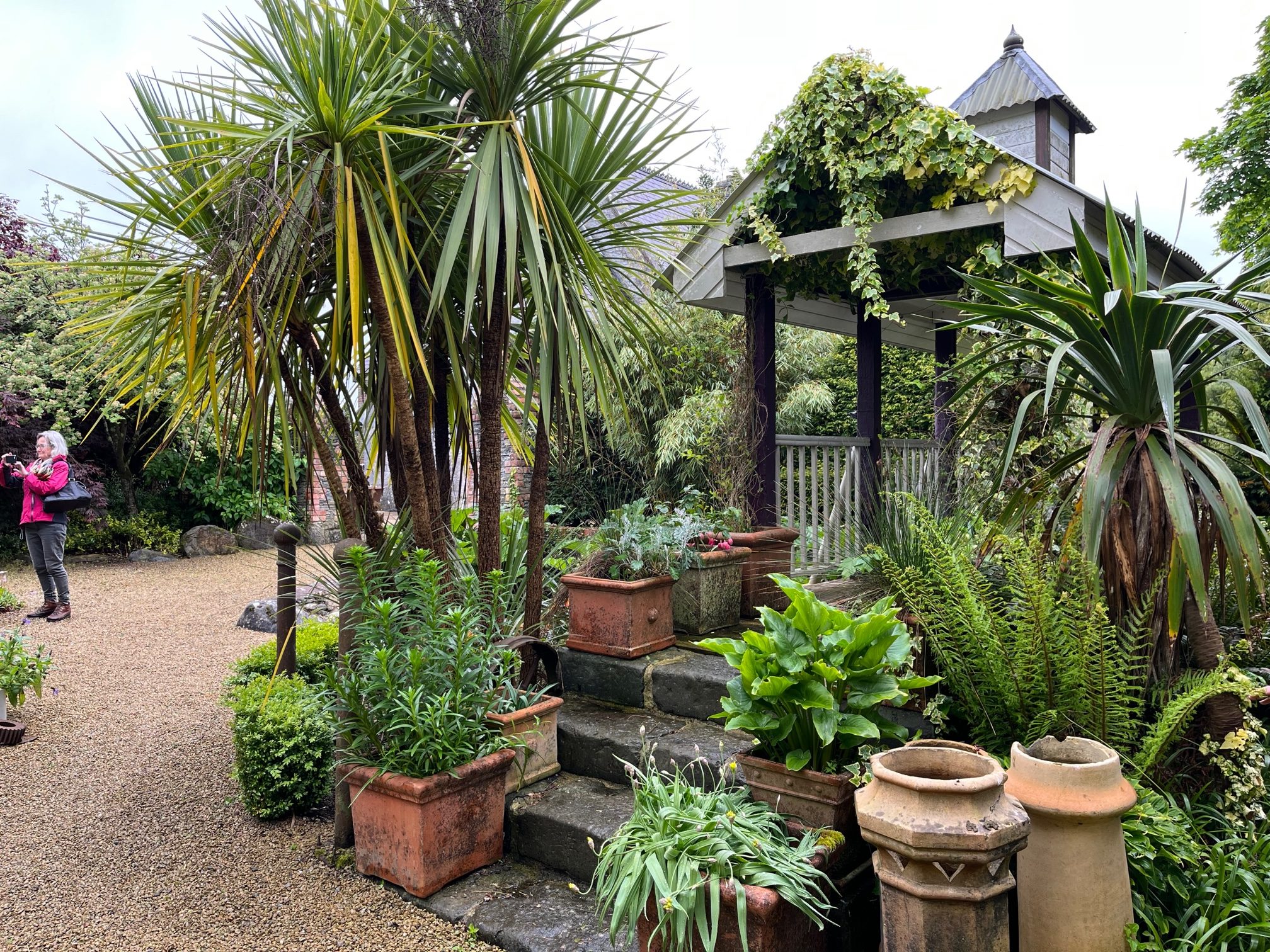

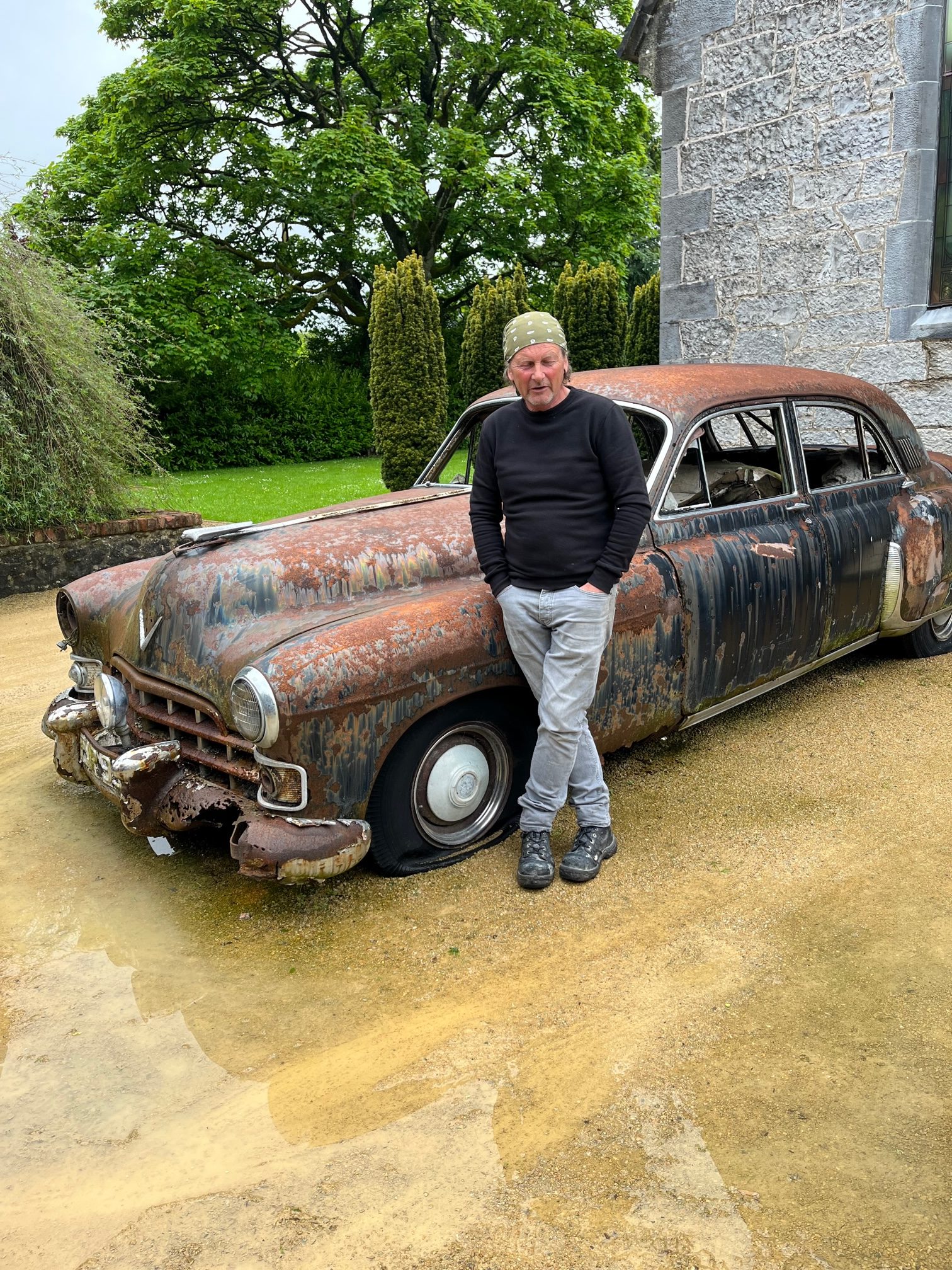
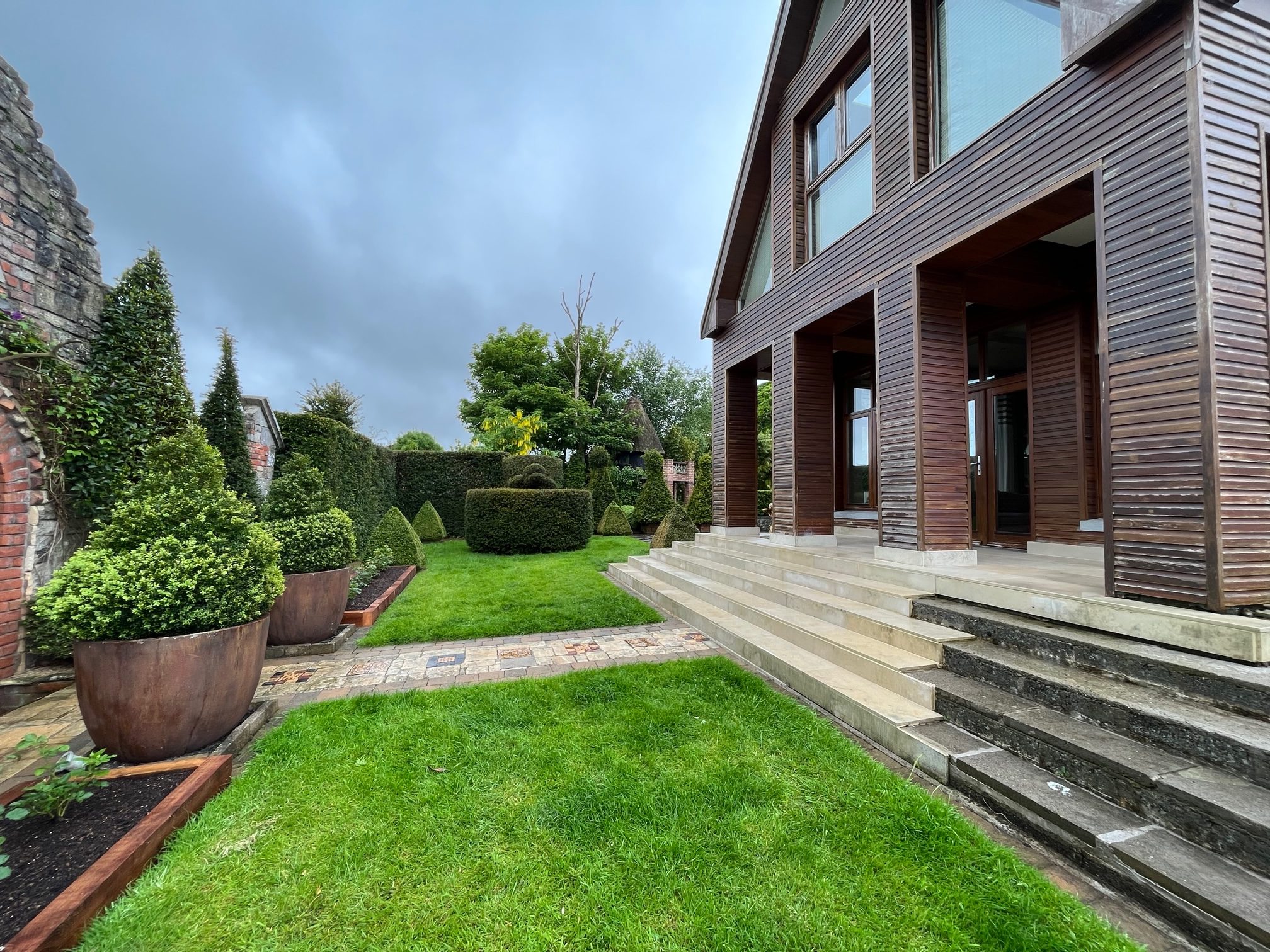
Then on to the last feature of our tour at the home of Kevin Begley who had provided so much input and help for the whole tour, masterminding many of the details of the trip along with Clare Fennessy, a former nursery owner and passionate gardener.
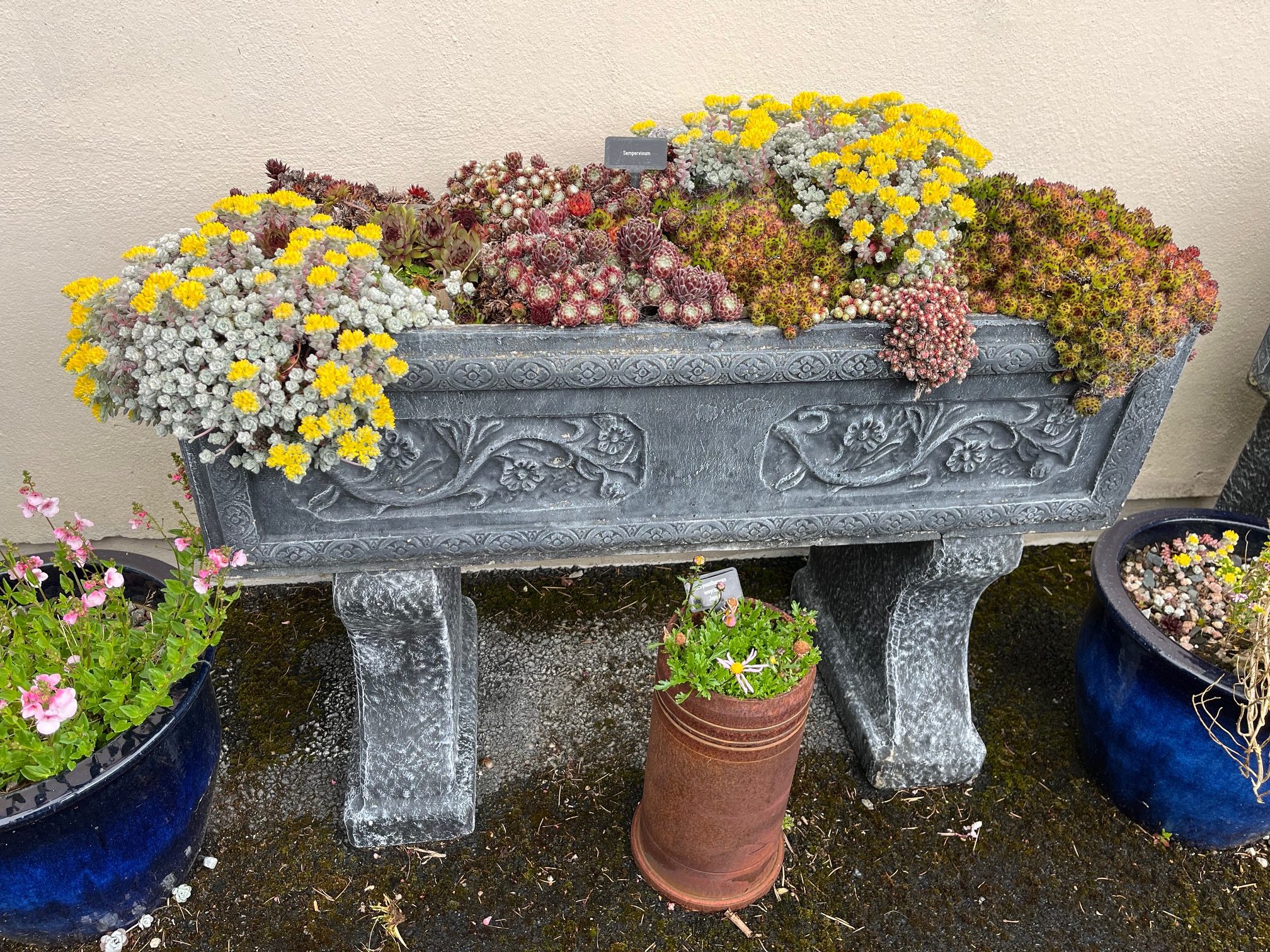
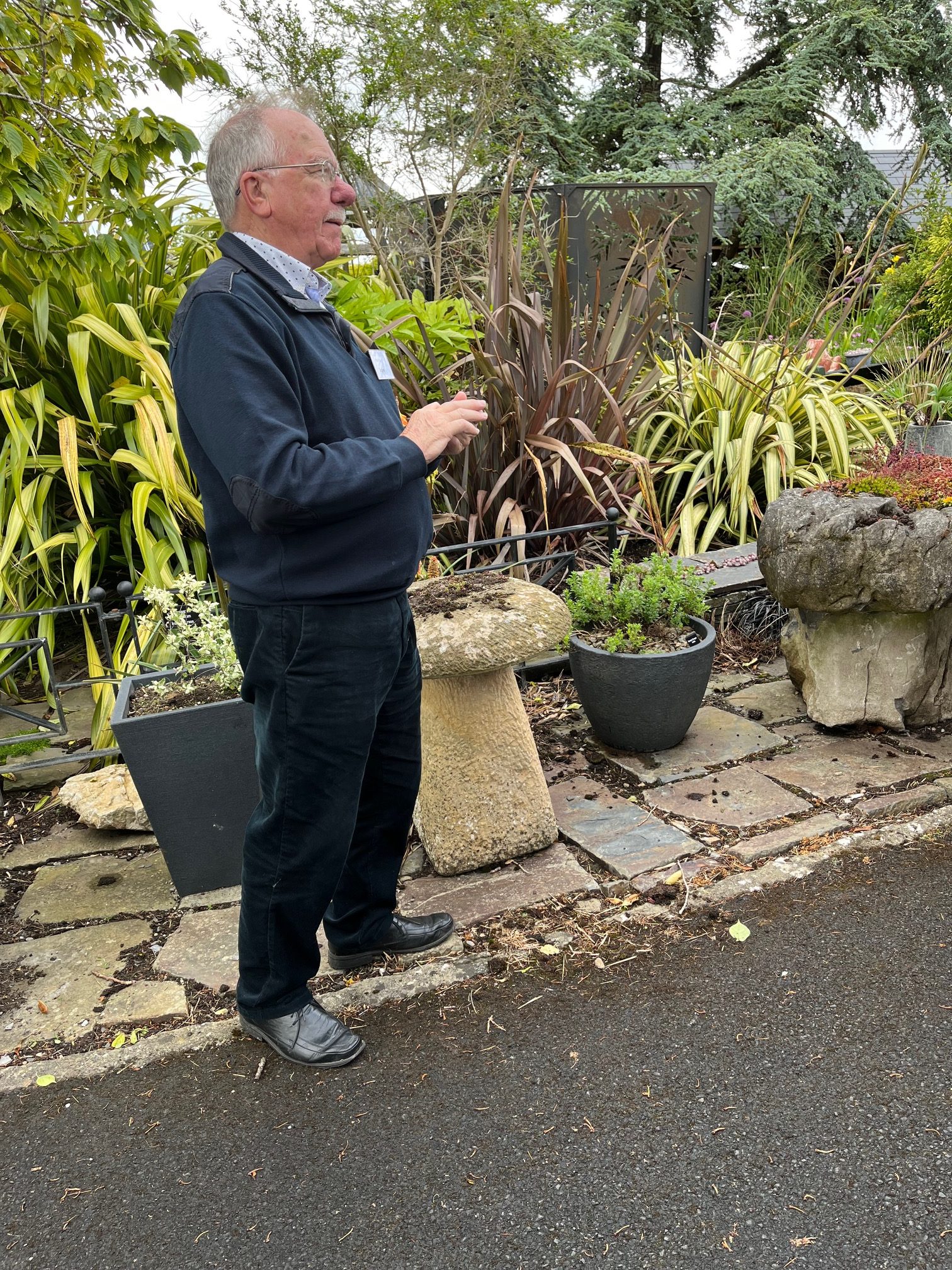
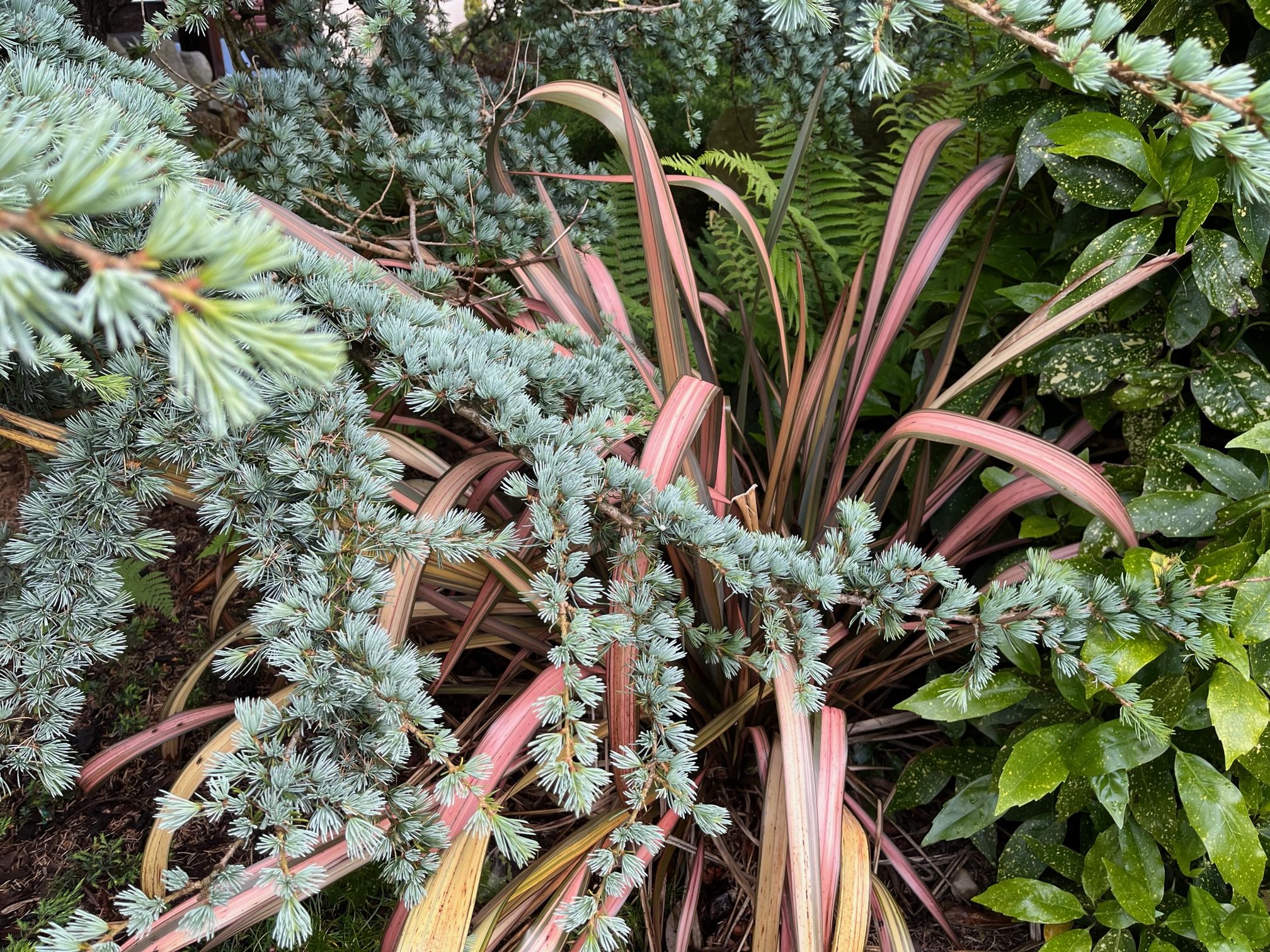
Coolwater’s collection of plants is staggering, with trees from the southern hemisphere, rare bamboos, hundreds of alpines and ferns in dozens of pots, chunks of rock, troughs as well as between and among the paving stones. Kevin gave us a guided tour. The water garden, overlooked by two gazebos (one floating on the pond), is stunning. There is a new alpine house and a large shed housing an Austin Healey 3000 Mk 1 “born 24 April 1960 in Abingdon,” Kevin says. From near the pond there are lovely views of Skule Hill and Rockstown Castle. At the end of the tour Kevin and Clare plied us with cakes and port.

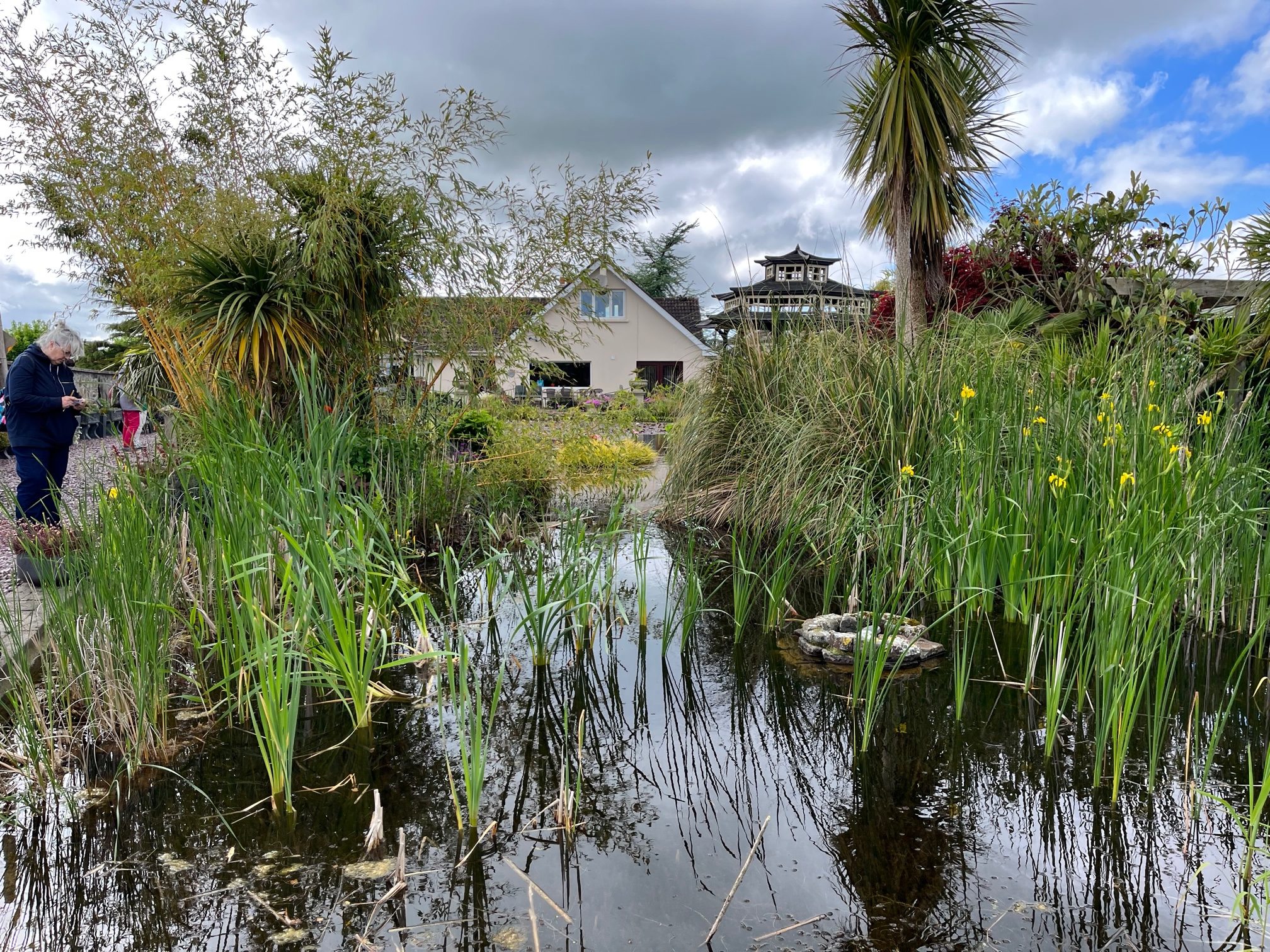
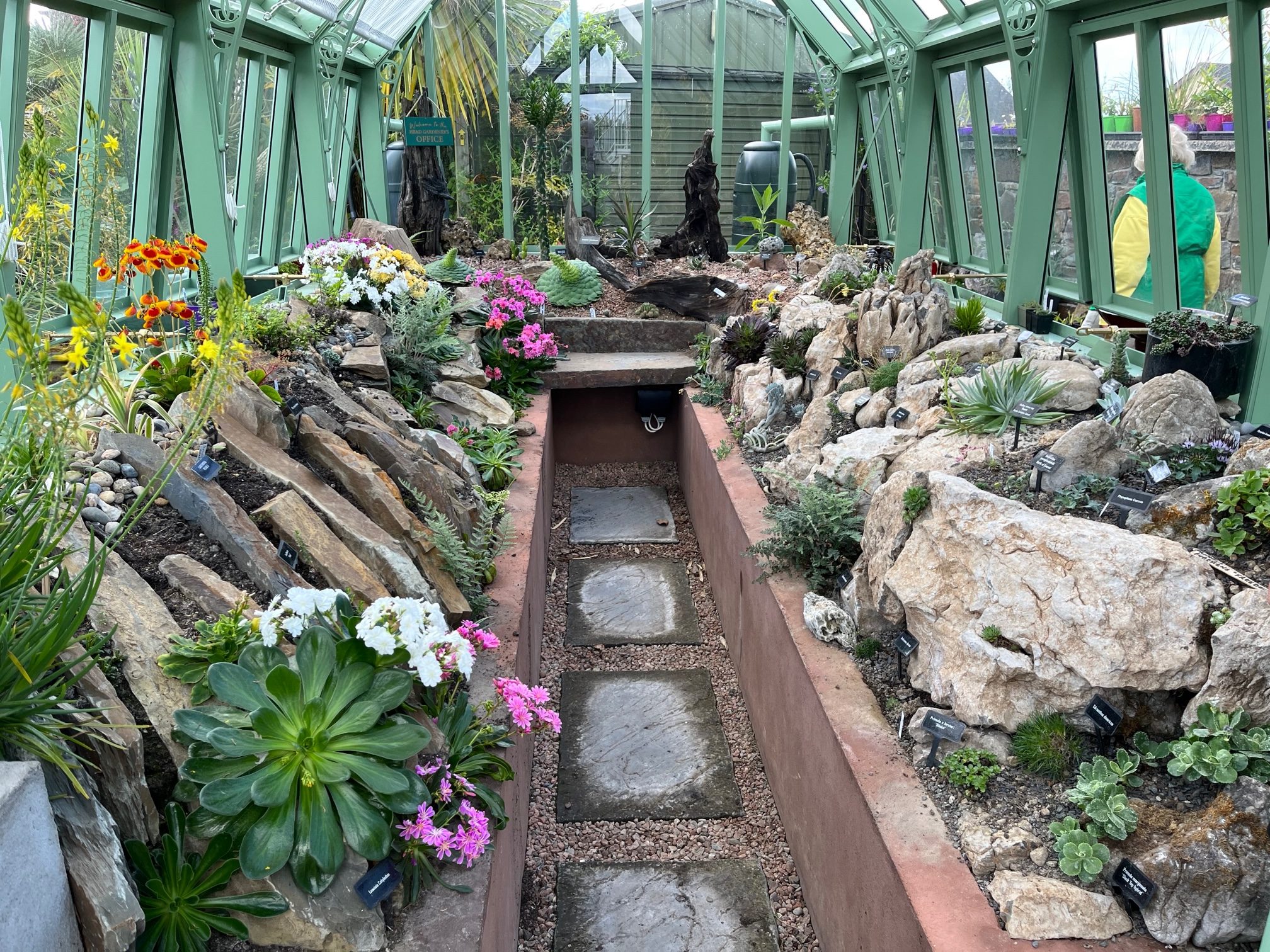
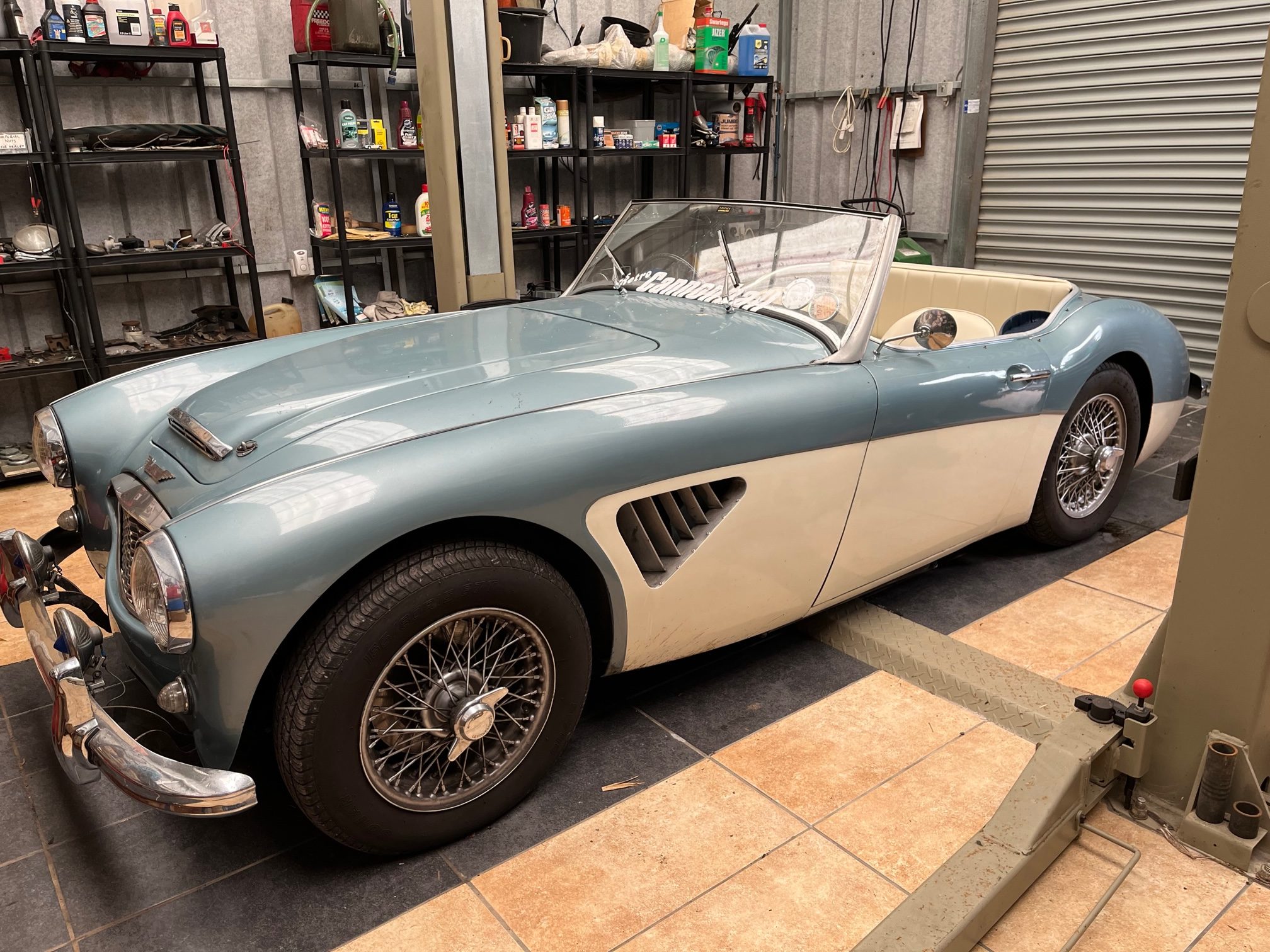

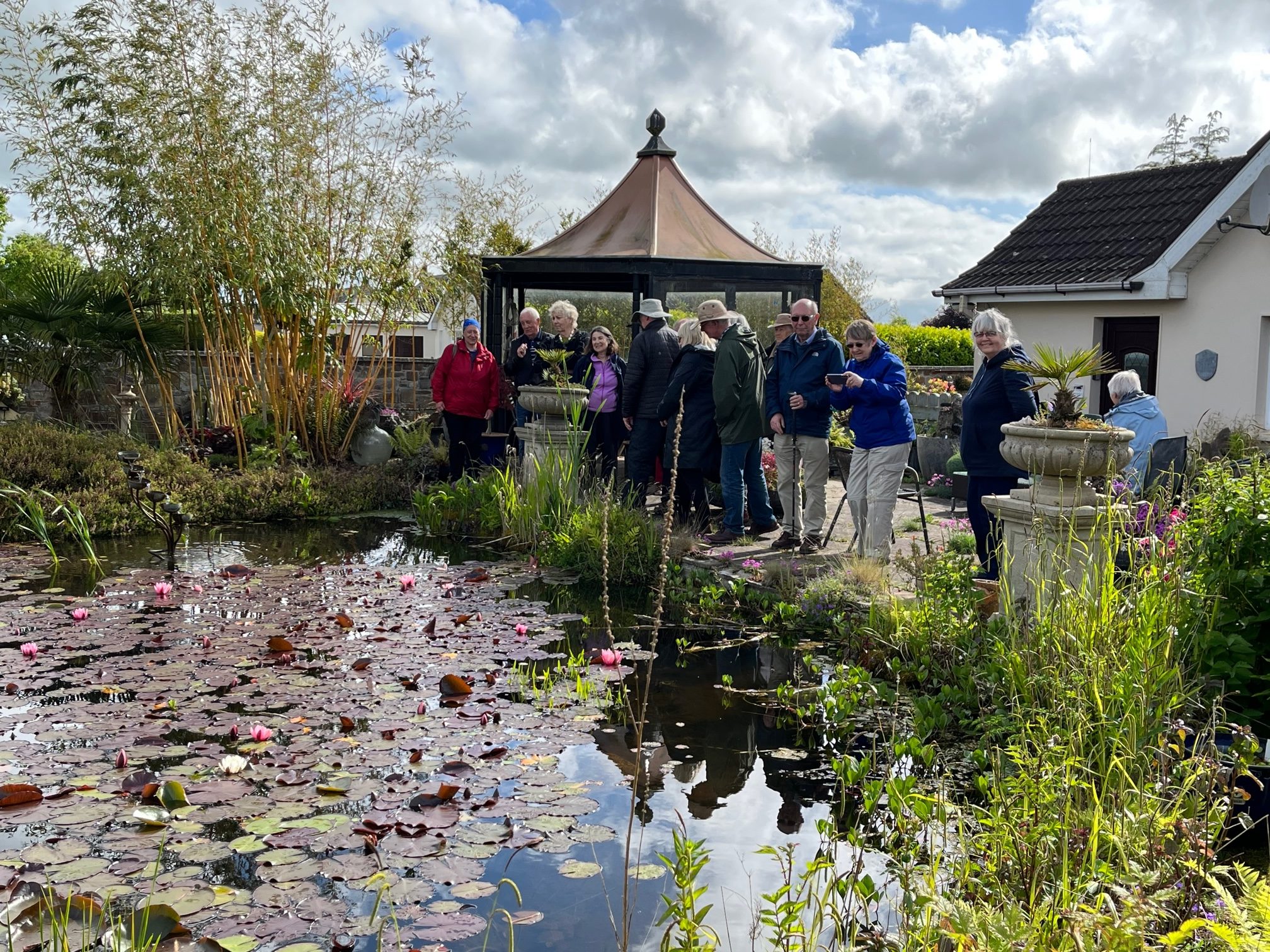
Coolwater
Thursday 26 May (Vida)
On the final day of the trip when most participants headed south from Shannon for a day of sightseeing and gardens, I and two others returned to the Burren for one last day of botanizing. We hiked a short section of the Burren Way – very short, because it’s hard to make progress when you spot a rare or interesting plant to admire every few meters! I saw thyme broomrape (Orobanche alba) just starting to emerge, a species with a very patchy distribution that is distinguished from common broomrape by its smaller stature. I also found many beautifully preserved fossils of Carboniferous age solitary corals in the rocks and boulders, a reminder of The Burren’s past as a warm, shallow sea 200 million years ago. The low water level in some of the smaller turloughs gave me the opportunity to explore the flora of the lowest vegetation zone which is often flooded.
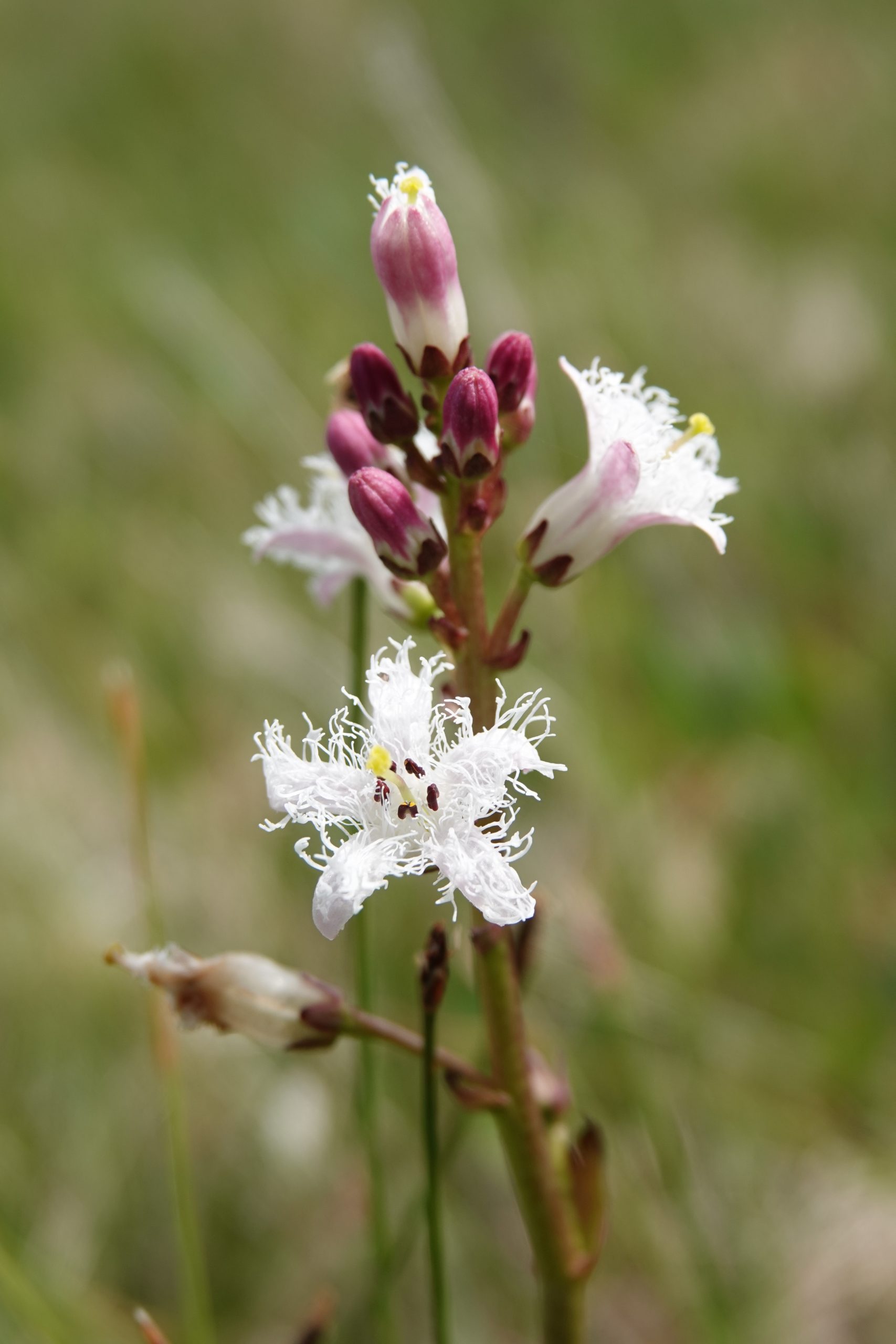
Menyanthes trifoliata
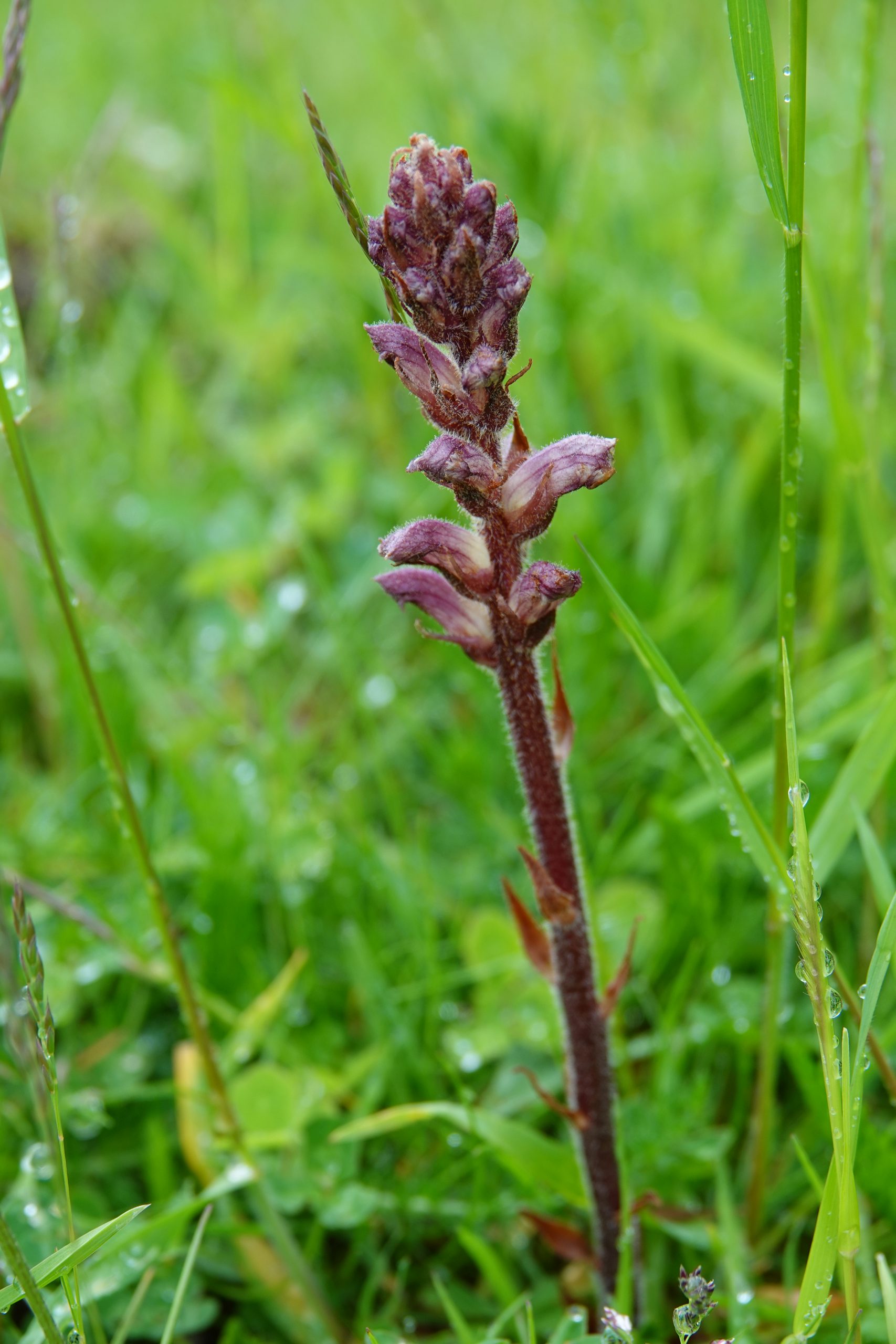
Orobanche alba
Beautiful bogbean (Menyanthes trifoliata) emerged from carpets of Cinclidotus fontinaloides, a moss which is so characteristic of these ephemeral lakes that it is sometimes called ‘black turlough moss’. I even managed to find a ‘swallow-hole’ among the moss, a small opening into the subterranean waterways active beneath the limestone. I saw lots more of the rare turlough plant shrubby cinquefoil (Dasiphora fruticosa) – it’s amazing how something that is so uncommon can be so abundant in the right spot. I hadn’t imagined finding nearly as many of the rare plants of the Burren in just four days as I did!
My long-standing desire to visit the Burren stemmed from a love of rare plants and a fascination with places where plants which usually aren’t found together thrive side by side. The Burren is perhaps the best example of this phenomenon in the British Isles, where arctic Dryas octopetala and Mediterranean Neotinea maculata bloom on the same cliff, where the foliage of subtropical Adiantum capillus-veneris and flowers of alpine Gentiana verna poke out of the same crack in the limestone pavement. I’ve spent the weeks after this trip reflecting on what I saw in Ireland – being able to explore the Burren in person gave me an understanding of how the exceptionally unique conditions here beget the equally unique ecology associated with it. A serendipitous combination of geological activity, climatic factors, and human history associated with this part of Ireland has given rise to a botanical wonder that is probably not replicated anywhere else in the world.
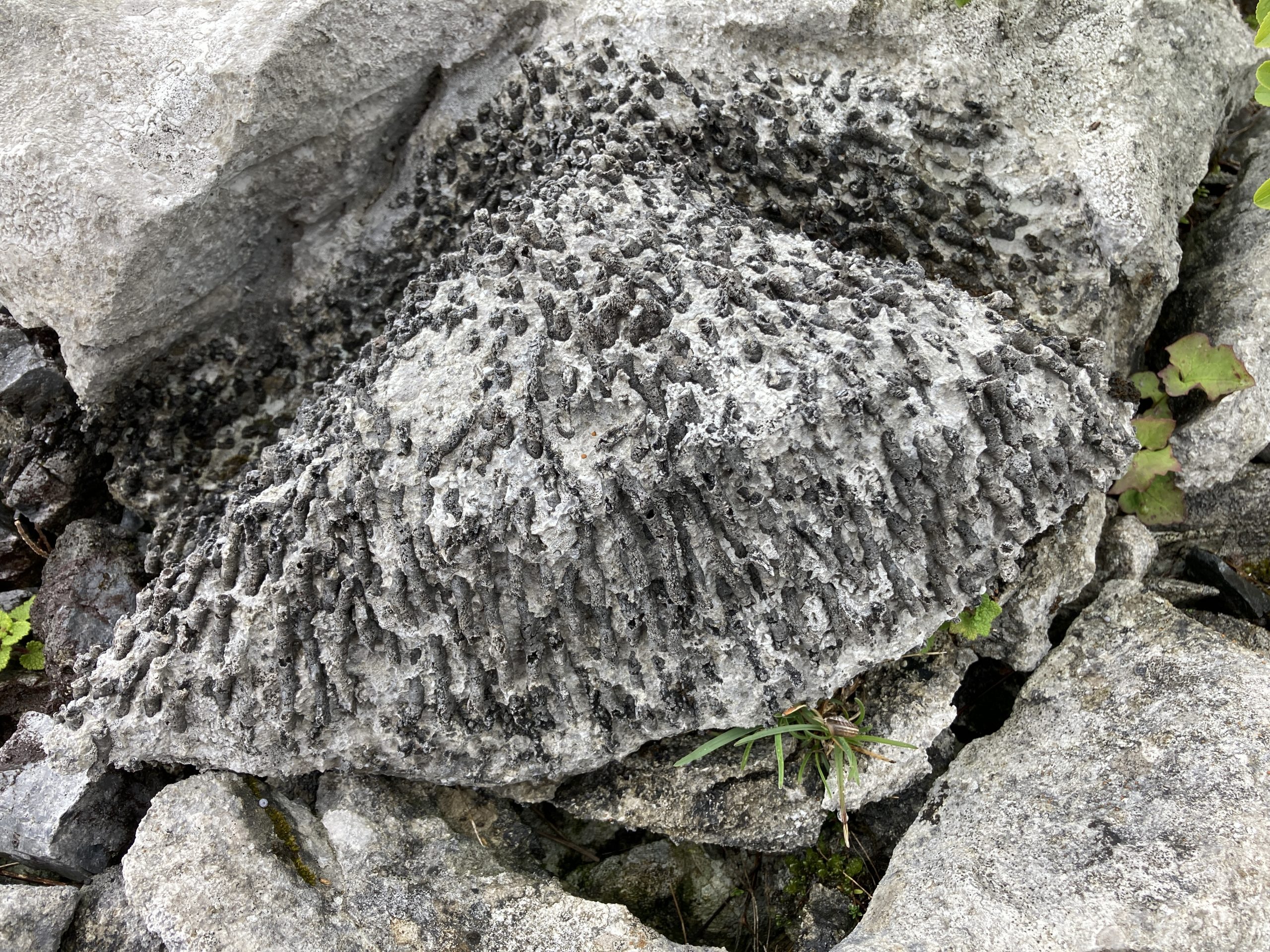
Fossils of carboniferous corals on the Burren Way
I would like to thank the members of Mediterranean Plants and Gardens for their incredible generosity which enabled me to come on this trip. I am especially grateful to Heather Martin for organizing and leading the trip, as well as the other trip participants for sharing their knowledge and enthusiasm for plants with me.
Text: Vida Svahnström, Bridget Daniels and Heather Martin
Images: Vida Svahnström, Bridget Daniels, Heather Martin and Roisheen Childs

